
Mars is the fourth planet from the Sun, and the seventh largest. It’s the only planet we know of inhabited entirely by robots.

All About Mars

Small World
Mars is 53% smaller than Earth.
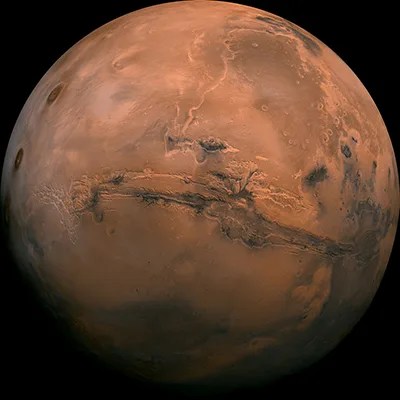
Fourth Rock
Mars is 1.52 AU from the Sun. Earth = 1.
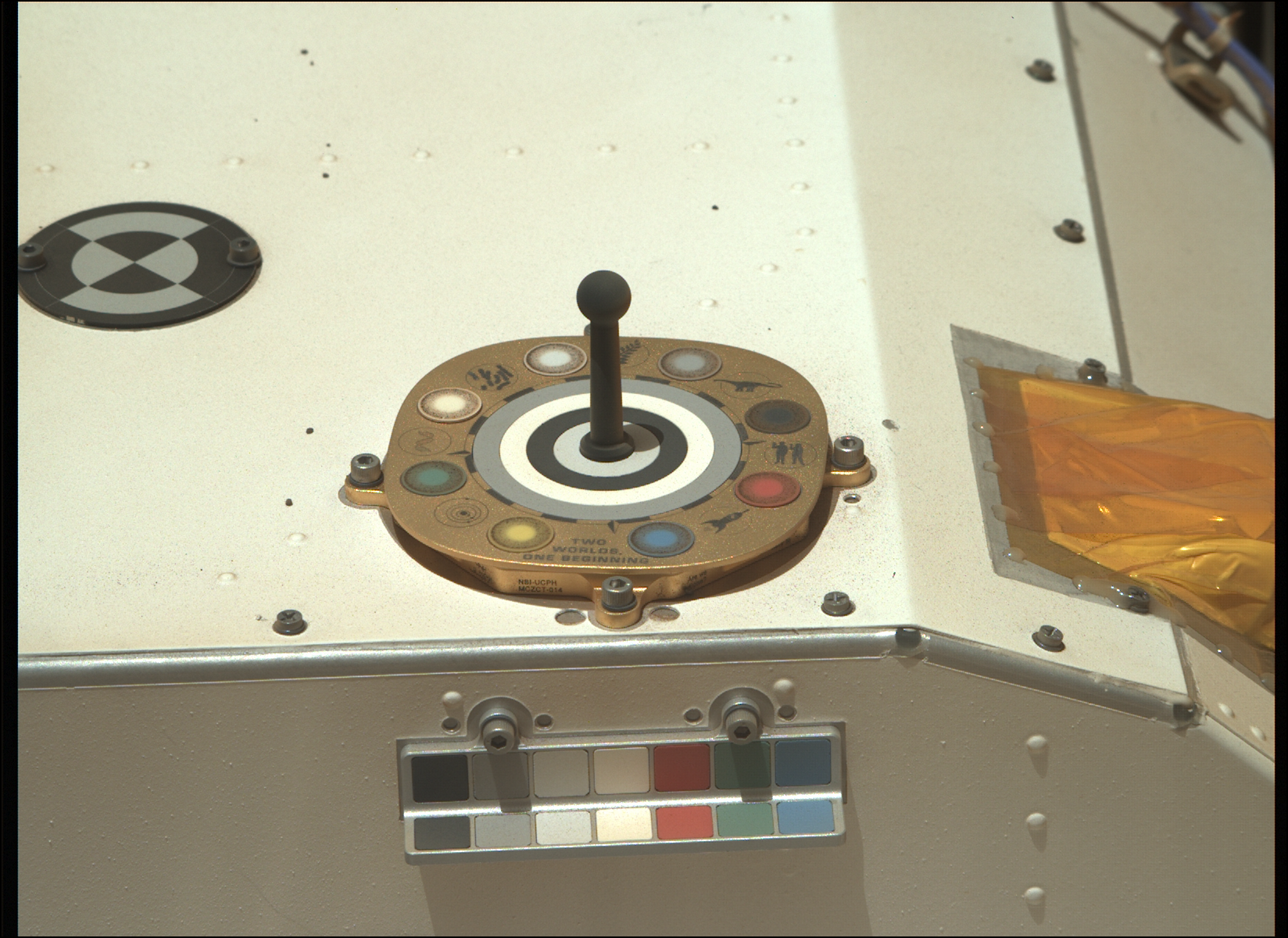
A Martian day is a little longer than Earth's; a Mars year is almost two Earth years.
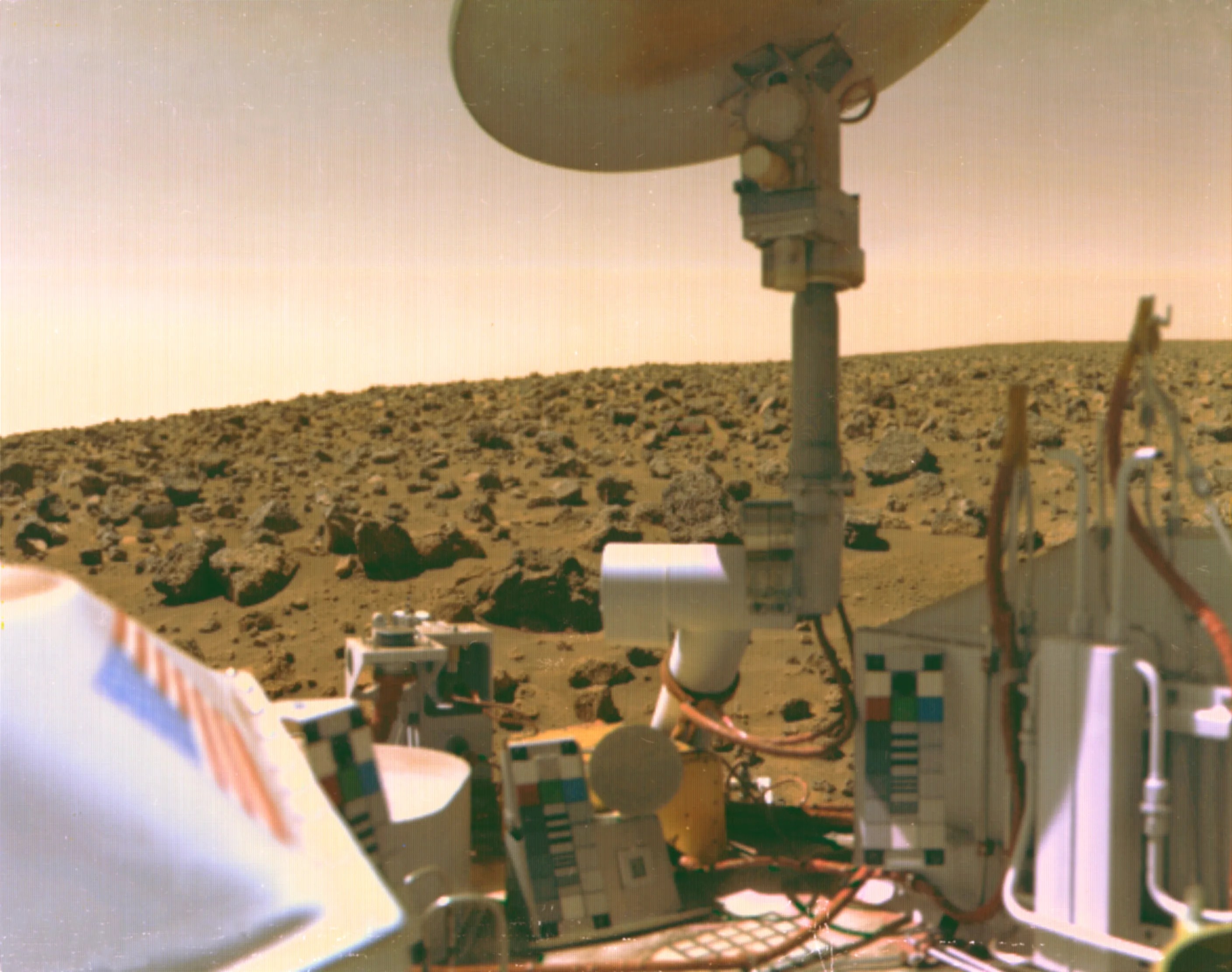
Rocky Planet
Mars' surface has been altered by volcanoes, impacts, winds, and crustal movement.
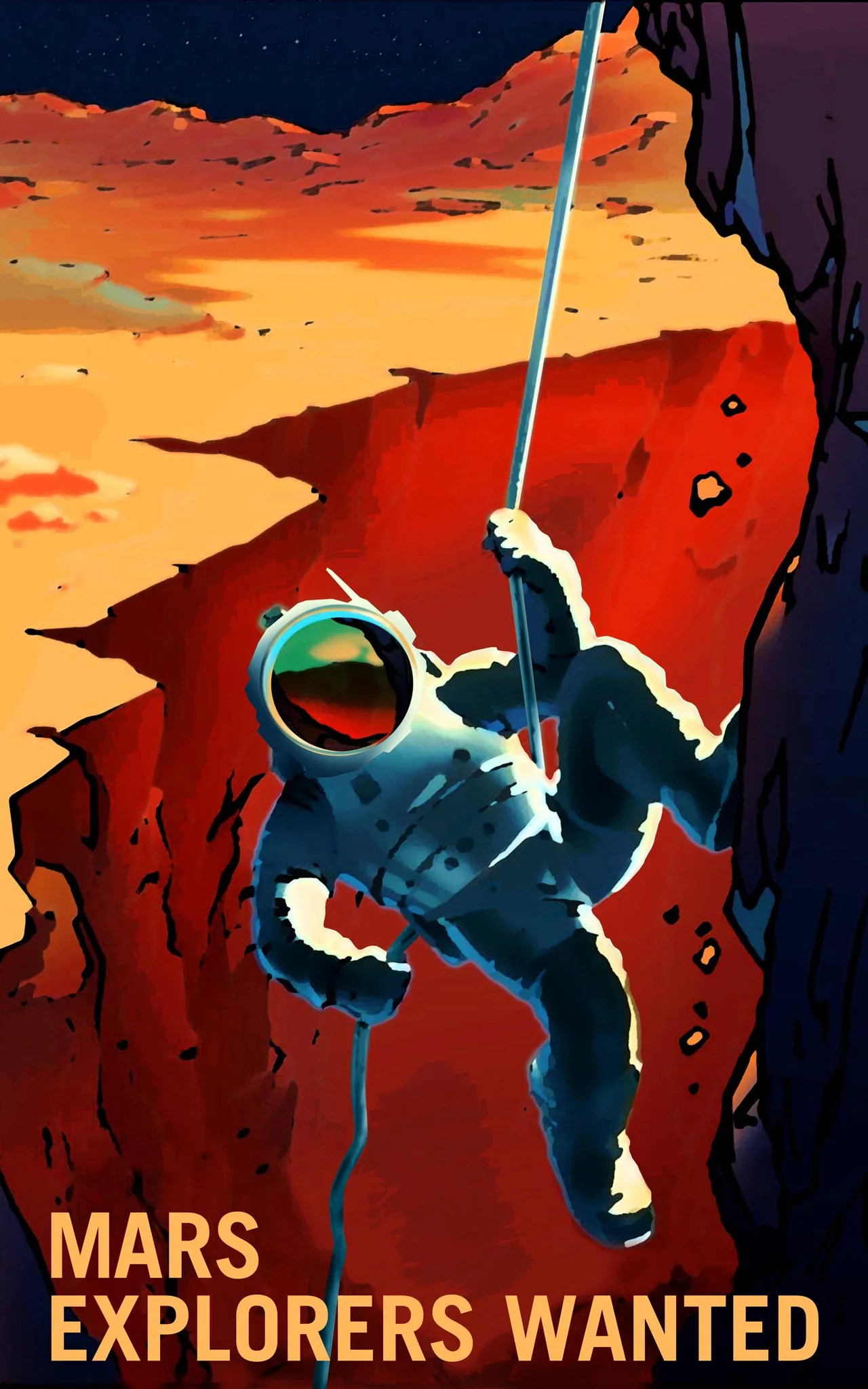
Bring a Spacesuit
Mars' atmosphere is mostly carbon dioxide, argon, and nitrogen.
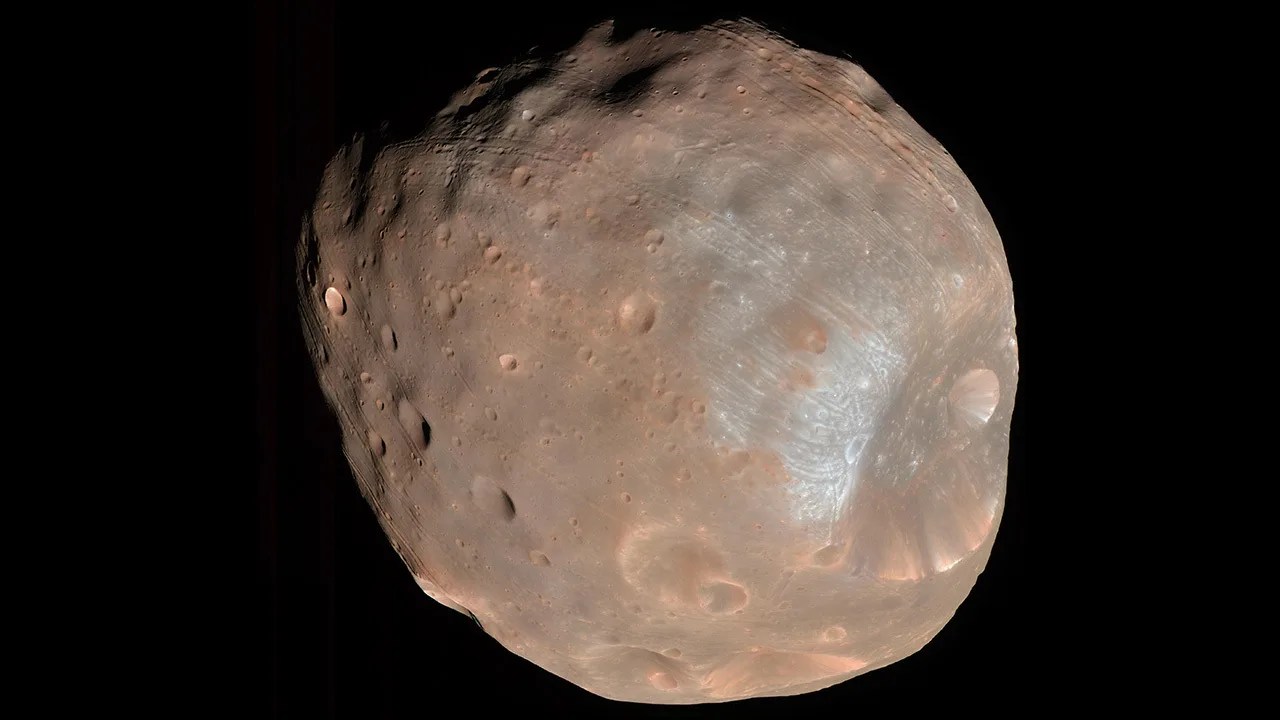
Phobos and Deimos are small compared to the planet.
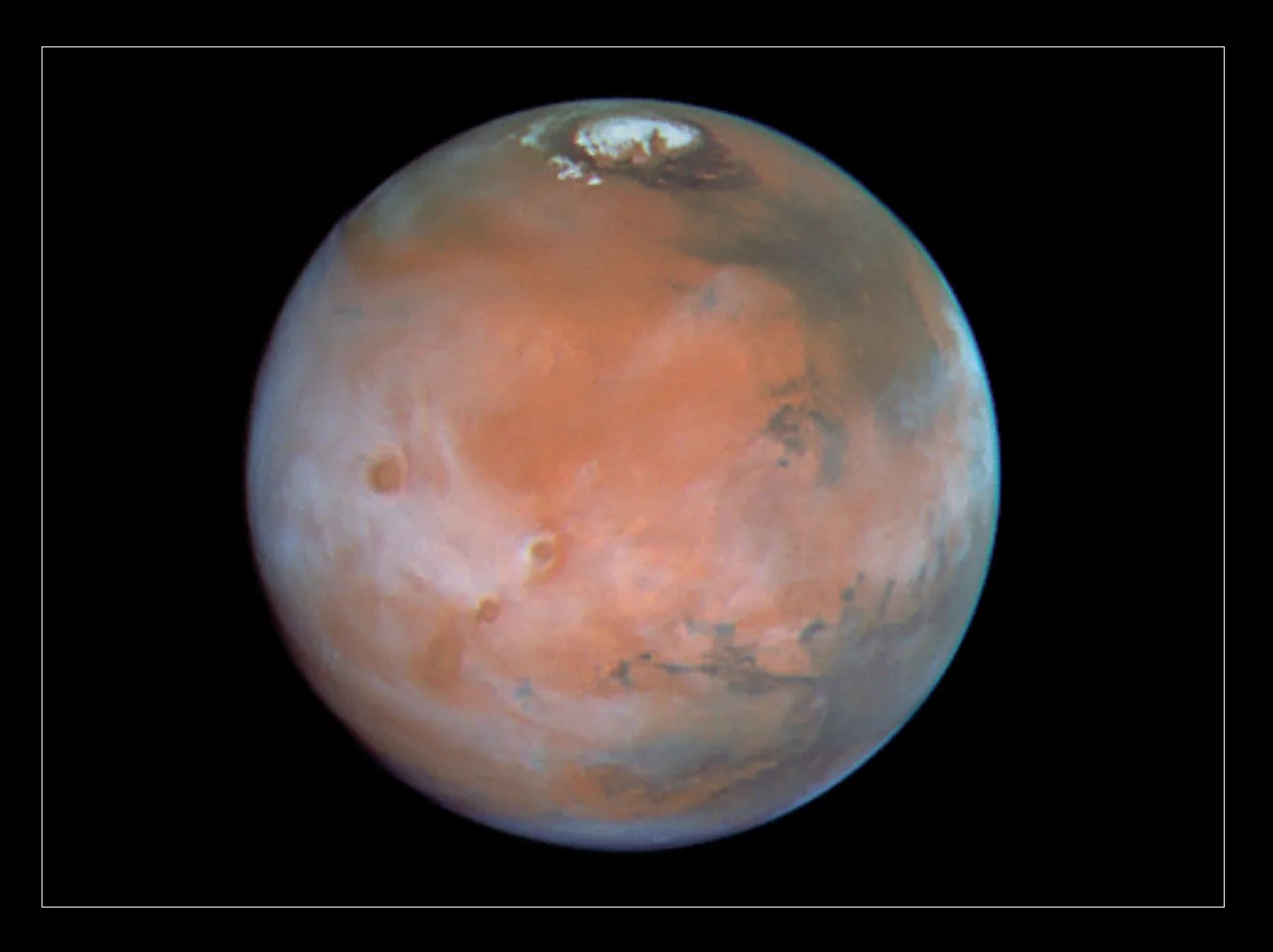
Mars has no rings.
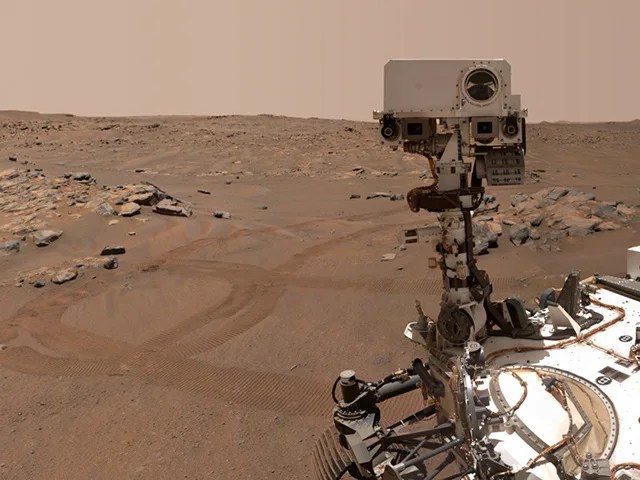
Many Missions
The first success was NASA's Mariner 4 flyby in 1965,

The Search for Life
Missions are determining Mars' past and future potential for life.
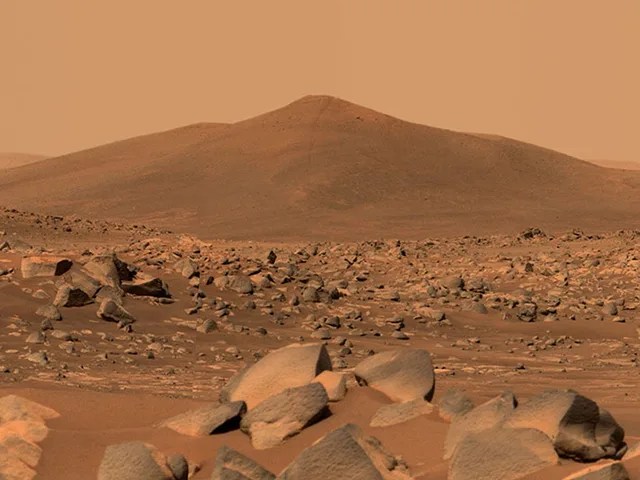
The Red Planet
Iron minerals in the Martian soil oxidize, or rust, causing the soil and atmosphere to look red.
Mars Overview
Mars is no place for the faint-hearted. It’s dry, rocky, and bitter cold. The fourth planet from the Sun, Mars, is one of Earth's two closest planetary neighbors (Venus is the other). Mars is one of the easiest planets to spot in the night sky – it looks like a bright red point of light.
Despite being inhospitable to humans, robotic explorers – like NASA's Perseverance rover – are serving as pathfinders to eventually get humans to the surface of the Red Planet.
Why Do We Go?
Mars is one of the most explored bodies in our solar system, and it's the only planet where we've sent rovers to explore the alien landscape. NASA missions have found lots of evidence that Mars was much wetter and warmer, with a thicker atmosphere, billions of years ago.
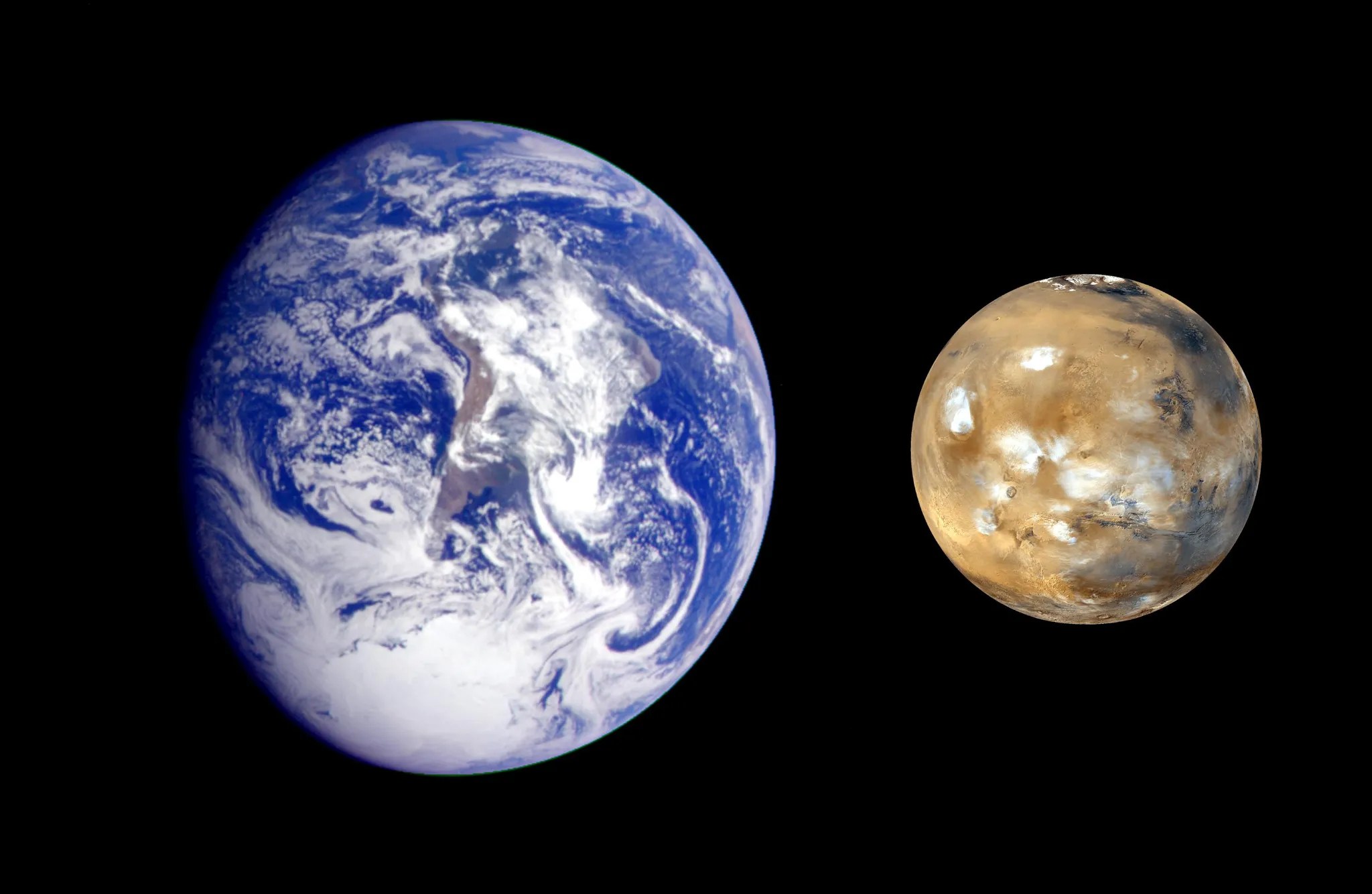
Mars Relay Network
How we explore.
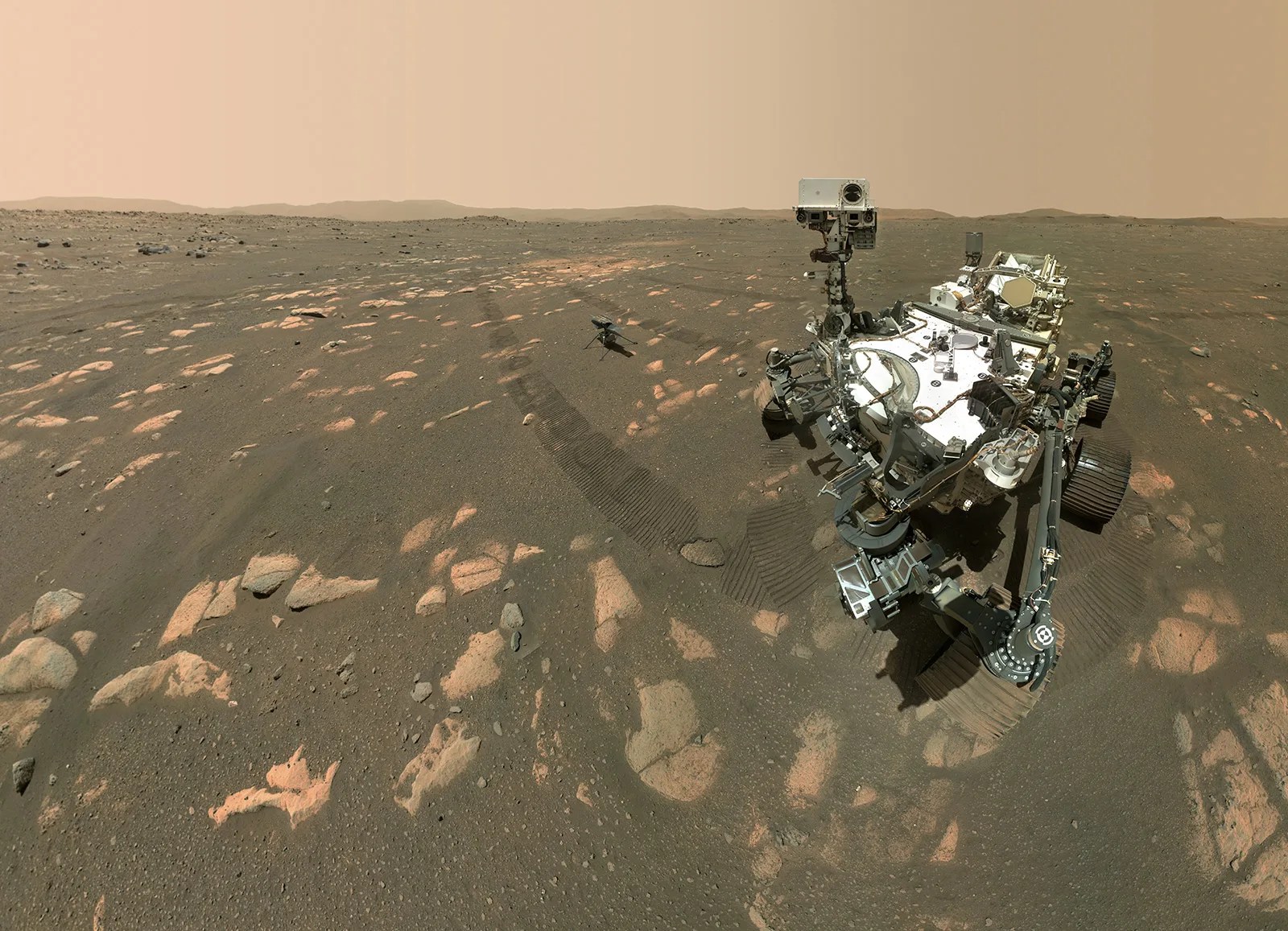
Mars 2020: Perseverance Rover
The Mars 2020 mission Perseverance rover is the first step of a proposed roundtrip journey to return Mars samples to Earth.
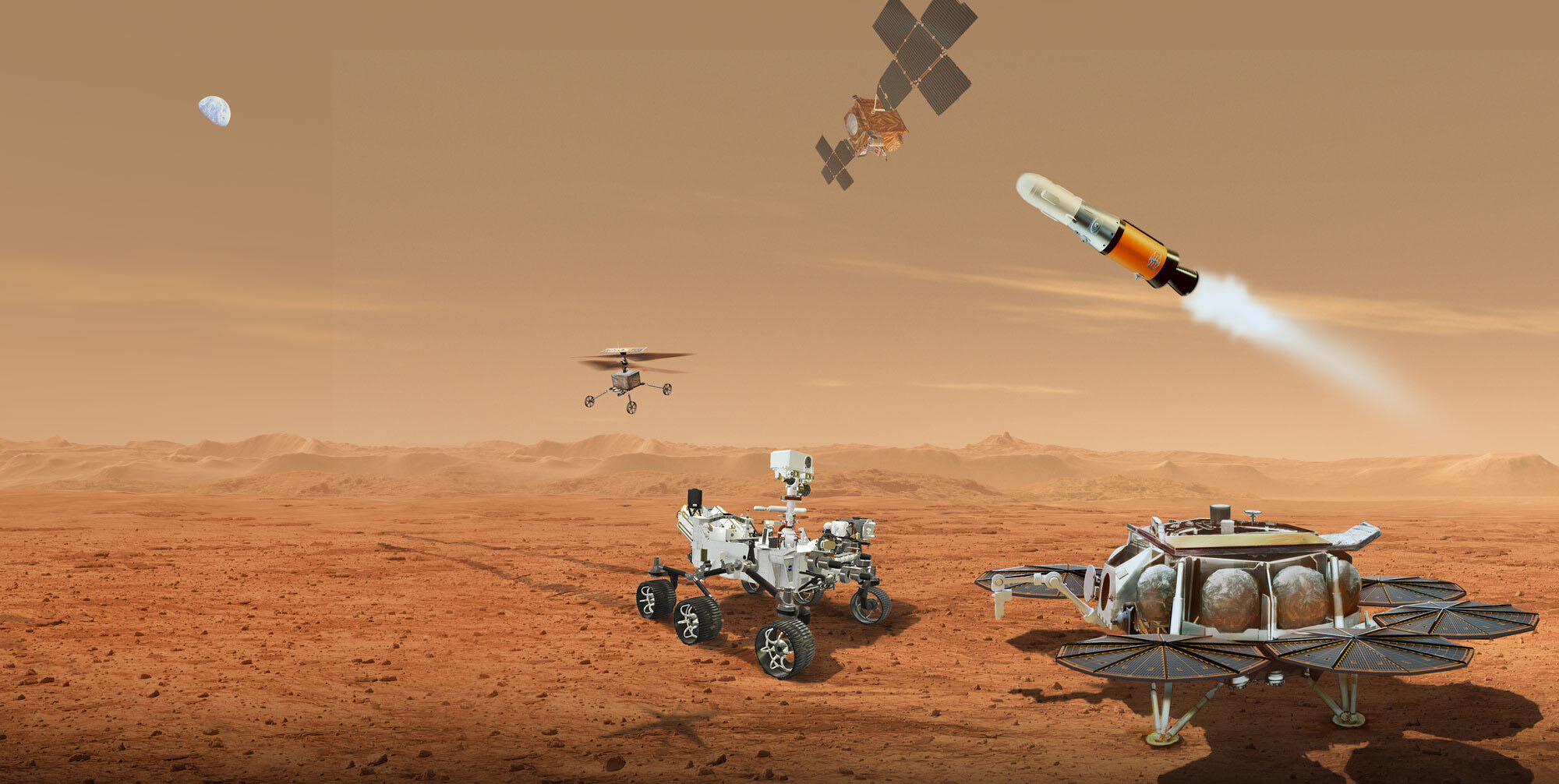
Mars Sample Return
NASA and ESA (European Space Agency) are planning ways to bring the first samples of Mars material back to Earth for detailed study.
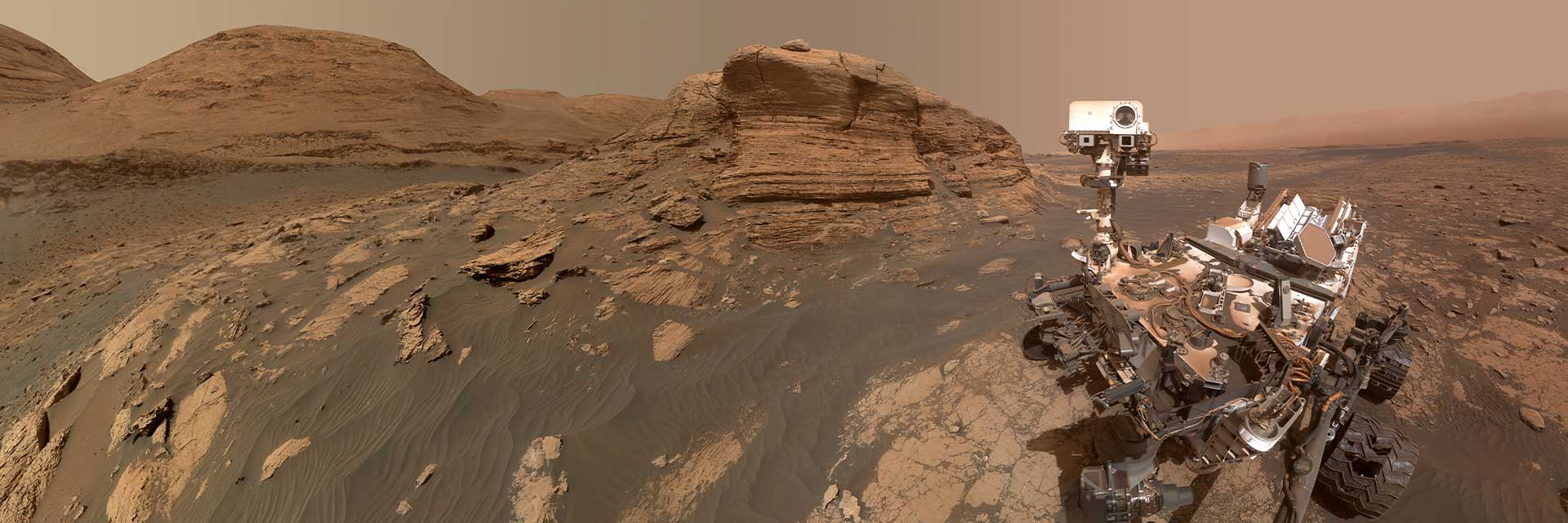
Mars Curiosity Rover (Mars Science Laboratory)
Curiosity is investigating Mars to determine whether the Red Planet was ever habitable to microbial life.
Mars Resources
View the one-stop shop for all Mars iconic images, videos, and more!
News & Features
NASA Technology Grants to Advance Moon to Mars Space Exploration
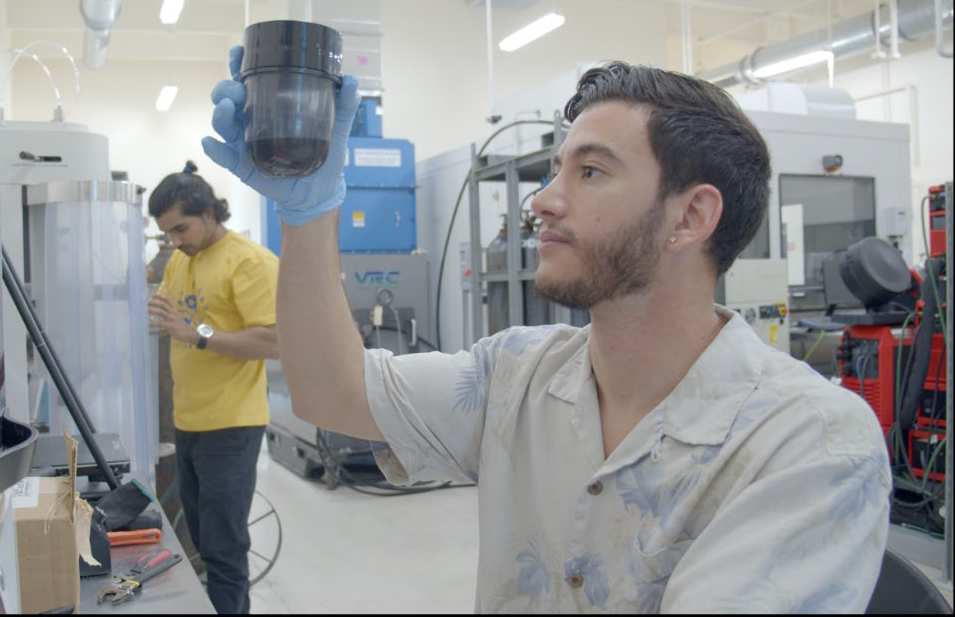
NASA Selects Commercial Service Studies to Enable Mars Robotic Science
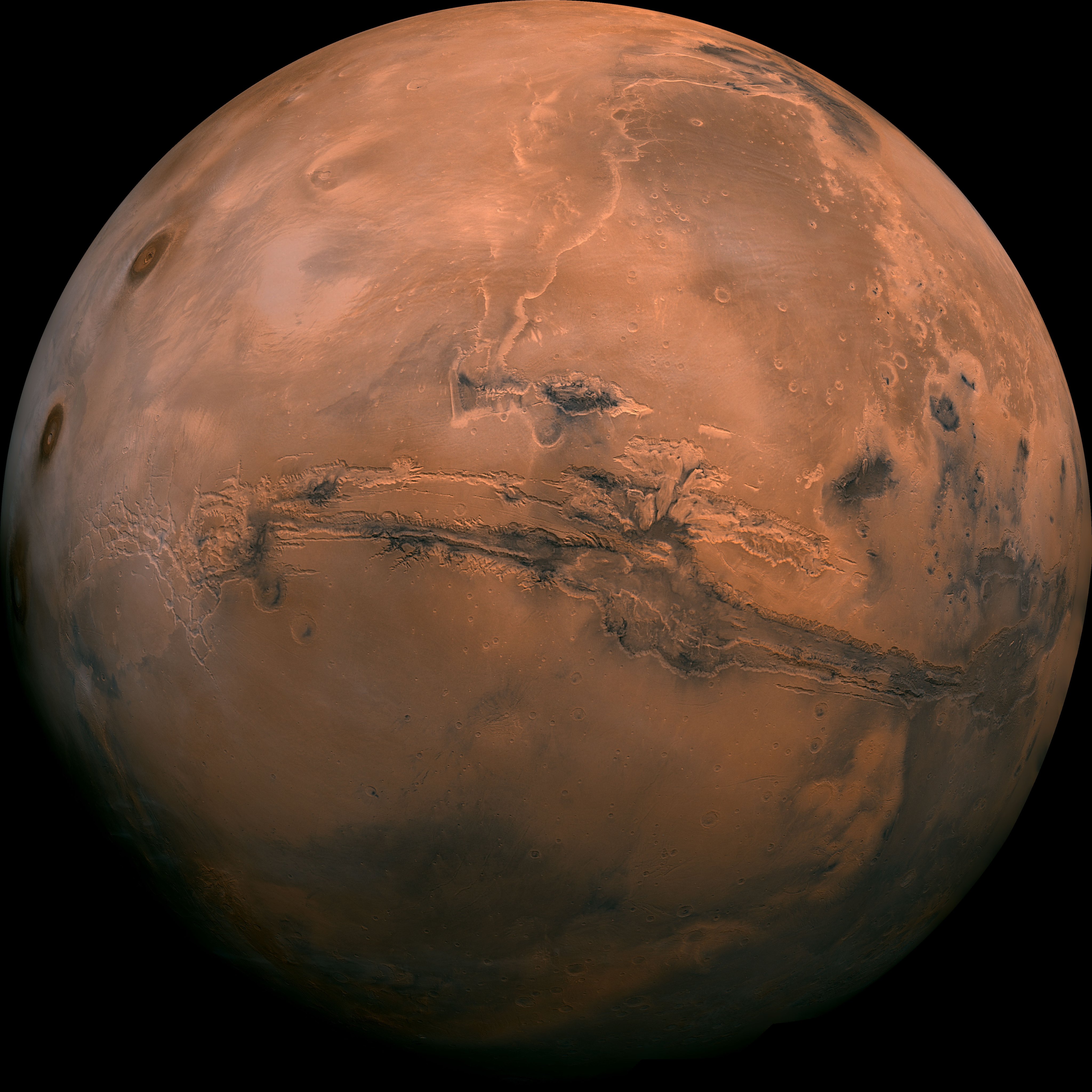
NASA Scientists Gear Up for Solar Storms at Mars

Major Martian Milestones

Why is Methane Seeping on Mars? NASA Scientists Have New Ideas
Beyond the Moon
Humans to mars.
Like the Moon, Mars is a rich destination for scientific discovery and a driver of technologies that will enable humans to travel and explore far from Earth.
Mars remains our horizon goal for human exploration because it is one of the only other places we know in the solar system where life may have existed. What we learn about the Red Planet will tell us more about our Earth’s past and future, and may help answer whether life exists beyond our home planet.

Discover More Topics From NASA

Why we explore Mars—and what decades of missions have revealed
In the 1960s, humans set out to discover what the red planet has to teach us. Now, NASA is hoping to land the first humans on Mars by the 2030s.

Mars has captivated humans since we first set eyes on it as a star-like object in the night sky. Early on, its reddish hue set the planet apart from its shimmering siblings, each compelling in its own way, but none other tracing a ruddy arc through Earth’s heavens. Then, in the late 1800s, telescopes first revealed a surface full of intriguing features—patterns and landforms that scientists at first wrongly ascribed to a bustling Martian civilization. Now, we know there are no artificial constructions on Mars. But we’ve also learned that, until 3.5 billion years ago, the dry, toxic planet we see today might have once been as habitable as Earth.
Since the 1960s, humans have set out to discover what Mars can teach us about how planets grow and evolve, and whether it has ever hosted alien life. So far, only uncrewed spacecraft have made the trip to the red planet, but that could soon change. NASA is hoping to land the first humans on Mars by the 2030s—and several new missions are launching before then to push exploration forward. Here’s a look at why these journeys are so important—and what humans have learned about Mars through decades of exploration.
Why explore Mars
Over the last century, everything we’ve learned about Mars suggests that the planet was once quite capable of hosting ecosystems—and that it might still be an incubator for microbial life today.
Mars is the fourth rock from the sun, just after Earth. It is just a smidge more than half of Earth’s size , with gravity only 38 percent that of Earth’s. It takes longer than Earth to complete a full orbit around the sun—but it rotates around its axis at roughly the same speed. That’s why one year on Mars lasts for 687 Earth days , while a day on Mars is just 40 minutes longer than on Earth.
Despite its smaller size, the planet’s land area is also roughly equivalent to the surface area of Earth’s continents —meaning that, at least in theory, Mars has the same amount of habitable real estate. Unfortunately, the planet is now wrapped in a thin carbon dioxide atmosphere and cannot support earthly life-forms. Methane gas also periodically appears in the atmosphere of this desiccated world, and the soil contains compounds that would be toxic to life as we know it. Although water does exist on Mars, it’s locked into the planet’s icy polar caps and buried, perhaps in abundance, beneath the Martian surface .
Today, when scientists scrutinize the Martian surface, they see features that are unquestionably the work of ancient, flowing liquids : branching streams, river valleys, basins, and deltas. Those observations suggest that the planet may have once had a vast ocean covering its northern hemisphere. Elsewhere, rainstorms soaked the landscape, lakes pooled, and rivers gushed, carving troughs into the terrain. It was also likely wrapped in a thick atmosphere capable of maintaining liquid water at Martian temperatures and pressures.
For Hungry Minds
Somewhere during Martian evolution, the planet went through a dramatic transformation, and a world that was once rather Earthlike became the dusty, dry husk we see today. The question now is, what happened? Where did those liquids go, and what happened to the Martian atmosphere ?
Exploring Mars helps scientists learn about momentous shifts in climate that can fundamentally alter planets. It also lets us look for biosignatures, signs that might reveal whether life was abundant in the planet’s past—and if it still exists on Mars today. And, the more we learn about Mars, the better equipped we’ll be to try to make a living there, someday in the future.
Past missions, major discoveries
Since the 1960s, humans have sent dozens of spacecraft to study Mars . Early missions were flybys, with spacecraft furiously snapping photos as they zoomed past. Later, probes pulled into orbit around Mars; more recently, landers and rovers have touched down on the surface.
But sending a spacecraft to Mars is hard , and landing on the planet is even harder. The thin Martian atmosphere makes descent tricky, and more than 60 percent of landing attempts have failed. So far, four space agencies—NASA, Russia’s Roscosmos, the European Space Agency (ESA), and the Indian Space Research Organization (ISRO)—have put spacecraft in Martian orbit. With eight successful landings, the United States is the only country that has operated a craft on the planet’s surface. The United Arab Emirates and China might join that club if their recently launched Hope and Tianwen-1 missions reach the red planet safely in February 2021.
Early highlights of Mars missions include NASA's Mariner 4 spacecraft , which swung by Mars in July 1965 and captured the first close-up images of this foreign world. In 1971, the Soviet space program sent the first spacecraft into Martian orbit. Called Mars 3 , it returned roughly eight months of observations about the planet's topography, atmosphere, weather, and geology. The mission also sent a lander to the surface, but it returned data for only about 20 seconds before going quiet.

Over the subsequent decades, orbiters returned far more detailed data on the planet's atmosphere and surface, and finally dispelled the notion, widely held by scientists since the late 1800s, that Martian canals were built by an alien civilization. They also revealed some truly dramatic features: the small world boasts the largest volcanoes in the solar system, and one of the largest canyons yet discovered—a chasm as long as the continental United States. Dust storms regularly sweep over its plains, and winds whip up localized dust devils.
You May Also Like

Why this company sent ancient human fossils into space

Why go back to the moon? NASA’s Artemis program has even bigger ambitions

Second SpaceX megarocket launch ends with another explosion. What happens next?
In 1976, NASA’s Viking 1 and 2 became the first spacecraft to successfully operate on the planet’s surface, returning photos until 1982. They also conducted biological experiments on Martian soil that were designed to uncover signs of life in space—but their results were inconclusive , and scientists still disagree over how to interpret the data.
NASA’s Mars Pathfinder mission , launched in 1996, put the first free-moving rover—called Sojourner—on the planet. Its successors include the rovers Spirit and Opportunity , which explored the planet for far longer than expected and returned more than 100,000 images before dust storms obliterated their solar panels in the 2010s.
Now, two NASA spacecraft are active on the Martian surface: InSight is probing the planet’s interior and it has already revealed that “ marsquakes” routinely rattle its surface . The Curiosity rover , launched in 2012, is also still wheeling around in Gale Crater, taking otherworldly selfies, and studying the rocks and sediments deposited in the crater’s ancient lakebed.
Several spacecraft are transmitting data from orbit: NASA’s MAVEN orbiter , Mars Reconnaissance Orbiter , and Mars Odyssey ; ESA’s Mars Express and Trace Gas Orbiter ; and India’s Mars Orbiter Mission .
Together, these missions have shown scientists that Mars is an active planet that is rich in the ingredients needed for life as we know it—water, organic carbon , and an energy source. Now, the question is: Did life ever evolve on Mars , and is it still around?
Future of Mars exploration
Once every 26 months , Earth and Mars are aligned in a way that minimizes travel times and expense , enabling spacecraft to make the interplanetary journey in roughly half a year. Earth’s space agencies tend to launch probes during these conjunctions, the most recent of which happens in the summer of 2020. Three countries are sending spacecraft to Mars during this window: The United Arab Emirates, which launched its Hope spacecraft on July 20 and will orbit Mars to study its atmosphere and weather patterns; China, which launched its Tianwen-1 on July 23 , and the United States, currently targeting July 30 for the launch of its Perseverance rover .
Perseverance is a large, six-wheeled rover equipped with a suite of sophisticated instruments. Its target is Jezero Crater, site of an ancient river delta , and a likely location for ancient life-forms to have thrived. Once on the surface, Perseverance will study Martian climate and weather, test technologies that could help humans survive on Mars, and collect samples from dozens of rocks that will eventually be brought to Earth. Among its goals is helping to determine whether Mars was—or is—inhabited, making it a true life-finding Mars mission.
All of the robotic activity is, of course, laying the groundwork for sending humans to the next world over. NASA is targeting the 2030s as a reasonable timeframe for setting the first boots on Mars, and is developing a space capsule, Orion , that will be able to ferry humans to the moon and beyond.
Private spaceflight companies such as SpaceX are also getting into the Mars game. SpaceX CEO Elon Musk has repeatedly said that humanity must become “ a multiplanetary species ” if we are to survive, and he is working on a plan that could see a million people living on Mars before the end of this century.
Soon, in one way or another, humanity may finally know whether our neighboring planet ever hosted life—and whether there’s a future for our species on another world.
Related Topics
- SPACE EXPLORATION

What’s out there? Why humanity keeps pushing the cosmic frontier.
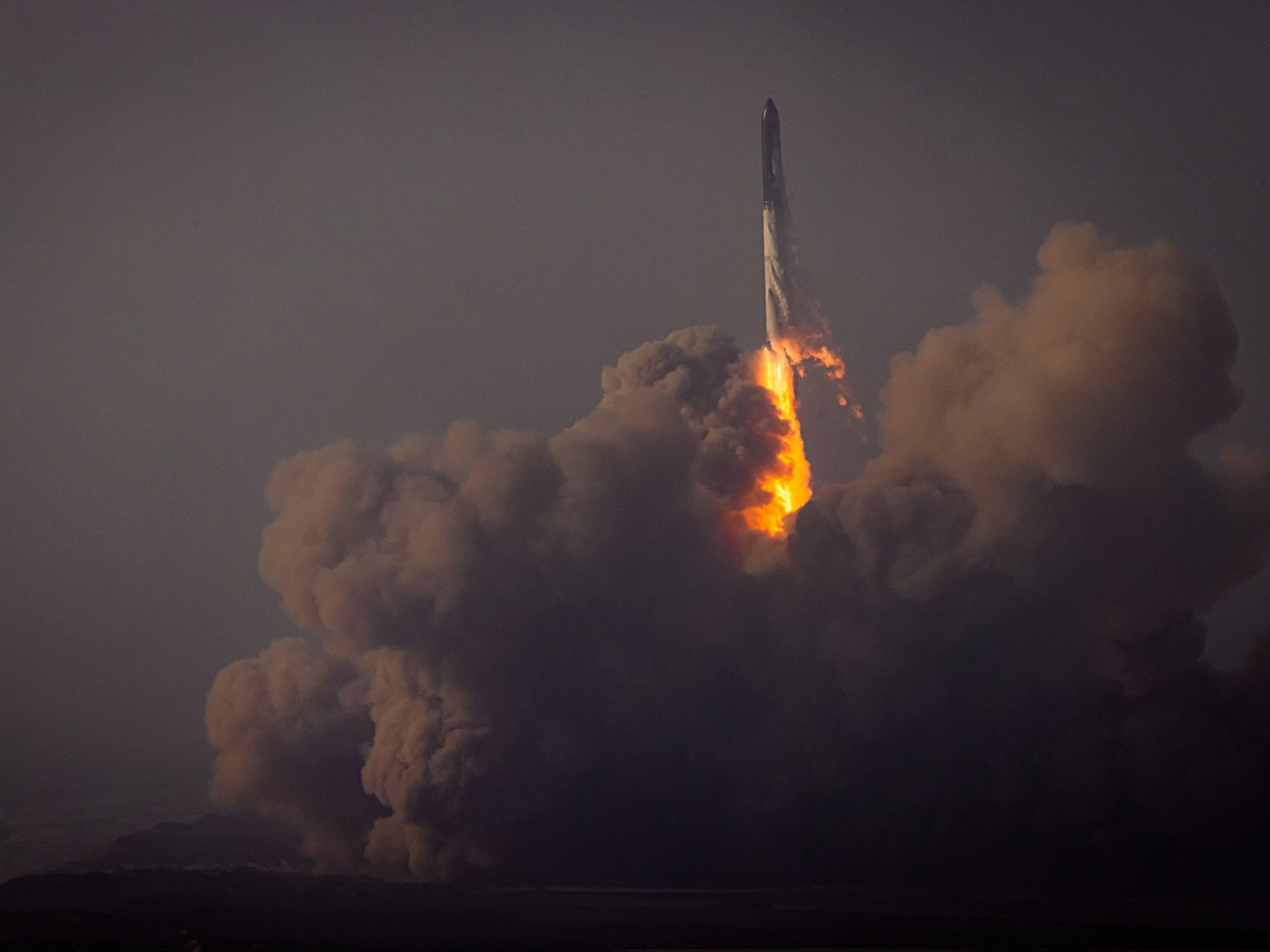
Starship’s fiery crash was still a win for the future of spaceflight. Here’s why.
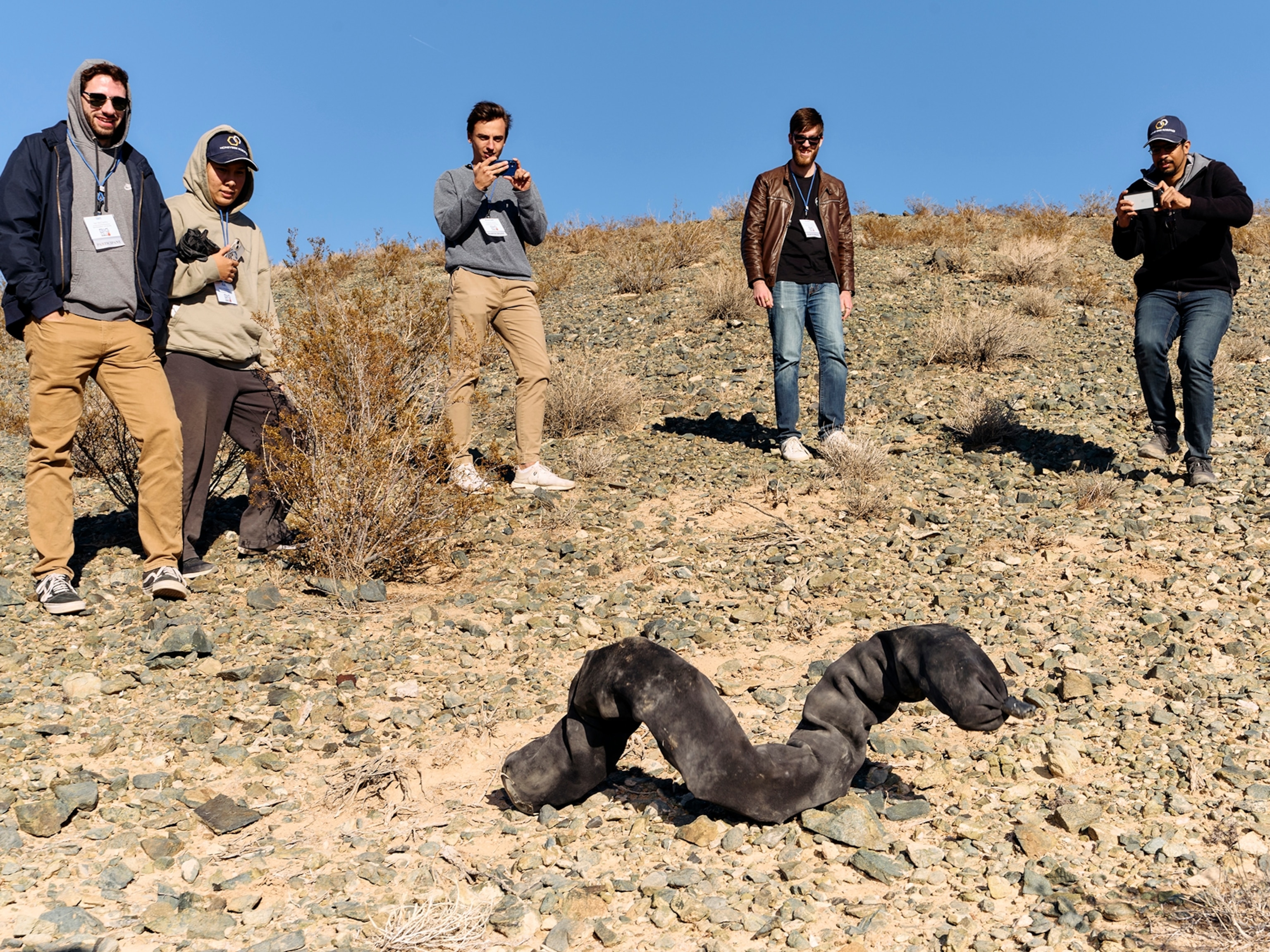
'Snakes' on the moon? These helpers could soon join our lunar mission.

Mars rover takes big steps in its most important mission

Why are people so dang obsessed with Mars?
- Environment
History & Culture
- History & Culture
- History Magazine
- Mind, Body, Wonder
- Coronavirus Coverage
- Paid Content
- Terms of Use
- Privacy Policy
- Your US State Privacy Rights
- Children's Online Privacy Policy
- Interest-Based Ads
- About Nielsen Measurement
- Do Not Sell or Share My Personal Information
- Nat Geo Home
- Attend a Live Event
- Book a Trip
- Inspire Your Kids
- Shop Nat Geo
- Visit the D.C. Museum
- Learn About Our Impact
- Support Our Mission
- Advertise With Us
- Customer Service
- Renew Subscription
- Manage Your Subscription
- Work at Nat Geo
- Sign Up for Our Newsletters
- Contribute to Protect the Planet
Copyright © 1996-2015 National Geographic Society Copyright © 2015-2024 National Geographic Partners, LLC. All rights reserved
The Nuclear Thermal Rocket That Could Get Us to Mars in Just 45 Days
The path to higher thrust propulsion starts here.

- NASA has hired Lockheed Martin to design, build, and test a nuclear-powered rocket for space travel.
- The technology could speed up a manned trip to Mars from the current seven-month minimum to as few as 45 days.
- A nuclear fission reactor would power the rocket’s engine for nuclear propulsion.
NASA and the U.S. Department of Defense’s Defense Advanced Research Projects Agency (DARPA) contracted Lockheed Martin to design, build, and test nuclear thermal rocket technology for a shorter, faster trip to the Red Planet. The rocket is also expected to operate with twice the efficiency as conventional chemical rockets, which combine fuel and an oxidizer for combustion power.
“Working with DARPA and companies across the commercial space industry will enable us to accelerate the technology development we need to send humans to Mars,” Pam Melroy, NASA deputy administrator, says in a statement . “This demonstration will be a crucial step in meeting our Moon-to-Mars objectives for crew transportation into deep space.”
Lockheed Martin will lead spacecraft design, integration, and testing of the roughly $500 million project, and BWX Technologies will design and build the nuclear fission reactor to power the engine.
Tabitha Dodson, DARPA program manager for the project, says in a statement that the DRACO project (Demonstration Rocket for Agile Cislunar Operations) “aims to give the nation leap-ahead propulsion capability.”
A nuclear thermal rocket could achieve high thrust—much like chemical propulsion—but is up to three times more efficient. This means that instead of the seven month-minimum it now takes to get to Mars , a nuclear-powered trip would only take 45 days . And going to Mars in 45 days isn’t the only benefit, as NASA is also looking for an efficient Earth-to-Moon connection.
“In order for our country, for our species, to further explore space, we need changes in more efficient propulsion,” Kirk Shireman, Lockheed Martin’s vice president for lunar exploration campaign, said in a press conference, according to the Washington Post . “Higher thrust propulsion is really, really important. And I think we’re on the cusp of that here.”
The United States started down the nuclear rocket path in the 1950s, but the idea was scraped during a 1970s budget cut. The DRACO program aims to build on that early research, but with a new fuel option for fewer logistical hurdles. Using a high-assay, low-enriched uranium fuel, the fission -based reactor can split apart atoms, heat up liquid hydrogen, and shoot that high-temperature gas through an engine nozzle for the needed thrust.
The greater efficiency from a nuclear thermal rocket not only slashes transit time, but also reduces astronaut risks and cuts down on payload needs for both supplies and systems.
One challenge yet to be overcome, according to Live Science , is the need to heat the hydrogen to 4,400°F while also storing it a minus-420°F. “This is just as much a demonstration of on-orbit storage of cryogenic liquid hydrogen as it is a demo of the nuclear thermal rocket,” Dodson says.
In the hoped-for 2027 test launch, the engine’s fission reactor will stay turned off—for obvious safety reasons—until the rocket reaches its designated orbit. The U.S. Space Force will provide a launch vehicle to take the test vessel into space.
The initial DRACO test plans to send the craft at least 435 miles and no more than 1,240 miles into space. It has no planned maneuvers, and will instead allow the vehicle’s reactor to use the new fuel and collect data along the way. With a planned two months of liquid hydrogen stored on the craft, crews may also test, according to Space News , the possibility of an in-space refueling.
“We’re going to put this together,” Shireman told reporters, according to Live Science , “we’re going to fly this demonstration, gather a bunch of great data and really, we believe, usher in a new age for the United States [and] humankind, to support our space exploration mission.”
Tim Newcomb is a journalist based in the Pacific Northwest. He covers stadiums, sneakers, gear, infrastructure, and more for a variety of publications, including Popular Mechanics. His favorite interviews have included sit-downs with Roger Federer in Switzerland, Kobe Bryant in Los Angeles, and Tinker Hatfield in Portland.

.css-cuqpxl:before{padding-right:0.3125rem;content:'//';display:inline;} Moon and Mars .css-xtujxj:before{padding-left:0.3125rem;content:'//';display:inline;}

Human-Made Space Debris Could Crash on Mars

How to View the Solar Eclipse

How a Lunar Supercollider Could Upend Physics

The Moon Is Going Nuclear

Private Company to Mine Helium-3 from the Moon

3 Moons Emerged From Around Neptune and Uranus

4 People Are Spending a Year In a Martian World.

America Has Planted Its Feet on the Moon Once More

The Strange Origin of the Hollow Moon Conspiracy

The Moon Is Shrinking Where We're Trying to Land
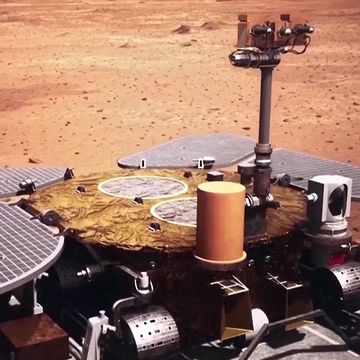
Rover Reveals Bizarre Shapes on Martian Surface
Want to travel to Mars? Here’s how long the trip could take.
Nuclear engines or not, you're gonna need a lot of PTO to get to the Red Planet.
By Eva Botkin-Kowacki | Published Feb 21, 2023 6:00 AM EST

Despite what Star Trek’s warp-speed journeys would have us believe, interplanetary travel is quite the hike. Take getting to Mars. Probes sent to the Red Planet by NASA and other space agencies spend about seven months in space before they arrive at their destination. A trip for humans would probably be longer—likely on the timescale of a few years.
There are a lot of things that a human crew needs to survive that robots don’t, such as food, water, oxygen, and enough supplies for a return—the weight of which can slow down a spacecraft. With current technology, NASA calculations estimate a crewed mission to Mars and back, plus time on the surface , could take somewhere between two and three years. “Three years we know for sure is feasible,” says Michelle Rucker, who leads NASA’s Mars Architecture Team in the agency’s Human Exploration and Operations Mission Directorate .
But NASA aims to shorten that timeline, in part because it would make a Mars mission safer for humans—we still don’t know how well the human body can withstand the environment of space for an extended period. (The record for most consecutive days in space is 437.) The agency is investing in projects to develop new propulsion technologies that might enable more expeditious space travel.
A crooked path to Mars
In a science-fictional world, a spacecraft would blast off Earth and head directly to Mars. That trajectory would certainly make for a speedier trip. But real space travel is a lot more complicated than going from point A to point B.
“If you had all the thrust you want, you could ignore the fact that there happens to be gravity in our universe and just plow all the way through the solar system,” says Mason Peck , a professor of astronautics at Cornell University who served as NASA’s chief technologist from 2011 to 2013. “But that’s not a scenario that’s possible right now.”
Such a direct trajectory has several challenges. As a spacecraft lifts off Earth, it needs to escape the planet’s gravitational pull, which requires quite a bit of thrust. Then, in space, the force of gravity from Earth, Mars, and the sun pulls the spacecraft in different directions. When it is far enough away, it will settle into orbit around the sun. Bucking that gravity requires fuel-intensive maneuvers.
[Related: Signs of past chemical reactions detected on Mars ]
The second challenge is that the planets do not stay in a fixed place. They orbit the sun, each at its own rate: Mars will not be at the same distance from Earth when the spacecraft launches as the Red Planet will be, say, seven months later.
As such, the most fuel-efficient route to Mars follows an elliptical orbit around the sun, Peck says. Just one-way, that route covers hundreds of millions of miles and takes over half a year, at best.
But designing a crewed mission to the Red Planet isn’t just about figuring out how fast a spacecraft can get there and back. It’s about “balance,” says Patrick Chai, in-space propulsion lead for NASA’s Mars Architecture Team . “There are a whole bunch of decisions we have to make in terms of how we optimize for certain things. Where do we trade performance for time?” Chai says. “If you just look at one single metric, you can end up making decisions that are really great for that particular metric, but can be problematic in other areas.”
One major trade-off for speed has to do with how much stuff is on board. With current technology, every maneuver to shorten the trip to Mars requires more fuel.
If you drive a car, you know that in order to accelerate the vehicle, you step on the gas. The same is true in a spacecraft, except that braking and turning also use fuel. To slow down, for instance, a spacecraft fires its thrusters in the opposite direction to its forward motion.
But there are no gas stations in space. More fuel means more mass on board. And more mass requires more fuel to propel that extra mass through the air… and so on. Trimming a round-trip mission down to two years is when this trade-off starts to become exponentially less efficient, Rucker says. At least, that’s with current technology.
New tech to speed up the trip
NASA would like to be able to significantly reduce that timeline. In 2018, the space agency requested proposals for technological systems that could enable small, uncrewed missions to fly from Earth to Mars in 45 days or less .
At the time, the proposals didn’t gain much traction. But the challenge inspired engineers to design innovative propulsion systems that don’t yet exist. And now, NASA has begun to fund the development of leading contenders. In particular, the space agency has its eye on nuclear propulsion.
Spacecraft currently rely largely on chemical propulsion. “You basically take an oxidizer and a fuel, combine them, and they combust, and that generates heat. You accelerate that heated product through a nozzle to generate thrust,” explains NASA’s Chai.
Engineers have known for decades that a nuclear-based system could generate more thrust using a significantly smaller amount of fuel than a chemical rocket. They just haven’t built one yet—though that might be about to change.
One of NASA’s nuclear investment projects aims to integrate a nuclear thermal engine into an experimental spacecraft. The Demonstration Rocket for Agile Cislunar Operations , or DRACO, program, is a collaboration with the Defense Advanced Research Projects Agency (DARPA), and aims to demonstrate the resulting technology as soon as 2027 .
[Related: Microbes could help us make rocket fuel on Mars ]
The speediest trip to Mars might come from another project, however. This concept, the brainchild of researchers at the University of Florida and supported by a NASA grant, seeks to achieve what Chai calls the “holy grail” of nuclear propulsion: a combination system that pairs nuclear thermal propulsion with an electric kind.
“We did some preliminary analysis, and it seems like we can get pretty close to [45 days],” says the leader of that project, Ryan Gosse, a professor of practice in the University of Florida’s in-house applied research program, Florida Applied Research in Engineering (FLARE). One caveat: That timeline is for a light payload and no humans on board. However, if the project is successful, the technology could potentially be scaled up in the future to support a crewed mission.

There are two types of nuclear propulsion, and both have their merits. Nuclear thermal propulsion, which uses heat, can generate a lot of thrust quickly from a small amount of fuel. Nuclear electric propulsion, which uses charged particles, is even more fuel-efficient but generates thrust much more slowly.
“While you’re in deep space, the electric propulsion is really great because you have all the time in the world to thrust. The efficiency, the miles per gallon, is far, far superior than the high-thrust,” Chai says. “But when you’re around planets, you want that oomph to get you out of the gravity well.”
The challenge, however, is that both technologies currently require different types of nuclear reactors, says Gosse. And that means two separate systems, which reduces the efficiency of having a nuclear propulsion system. So Gosse and his team are working to develop technology that can use the one system to generate both types of propulsion.
NASA’s Mars architecture team is also working with a bimodal concept that uses a chemical propulsion system to maneuver around planets and solar-powered electric propulsion to do the thrusting in deep space.
“What we are developing is different tools for the toolbox,” says NASA’s Rucker. “One tool isn’t going to be enough to do all of the exploration that we want to do. So we’re working on all of these.”
Like science, tech, and DIY projects?
Sign up to receive Popular Science's emails and get the highlights.
- Share full article
Advertisement
Supported by
To the Moon
Why NASA wants to go back now.

By German Lopez
Human beings will soon walk on the moon again, if NASA gets its way.
NASA plans to launch an uncrewed spacecraft, part of the Artemis I mission, as soon as this weekend to orbit the moon and then return to Earth after about a month and a half. If everything goes as planned, a future mission could land astronauts on the moon in 2025.
Today’s newsletter will explain why NASA is doing this now and what it means for the future of space travel.
Why the moon?
Several factors are driving NASA to get astronauts back to the moon for the first time in more than 50 years. One is a long-running desire to get human beings on Mars. The Artemis missions will test some of the technology and logistics required to do that.
“If you believe that the future of humanity is spreading across the solar system, the first stop has to be the moon,” my colleague Ken Chang, who covers NASA, told me. “If you can’t figure that out, you’re certainly not getting to Mars.”
But a mission to the moon also has some scientific value on its own. Rocks collected in previous missions, for example, revealed the moon’s origin: It likely formed from debris after an object the size of Mars hit Earth more than four billion years ago.
In the Artemis missions, NASA is especially interested in studying ice in lunar craters. Depending on how long it’s been there, the ice and its characteristics could provide a history of the solar system. The ice could also be used to establish permanent bases on the moon, if it can be turned into drinking water, oxygen or spacecraft fuel (as Ken explained in The Times ).
And the missions could produce collateral benefits. Past innovations in the space program have led to technological advancements in everyday life, including in computing and food preservation.
What’s next?
This weekend’s launch was originally scheduled for this past Monday, but NASA postponed it after finding a technical problem shortly before takeoff. It could be delayed again, possibly for months, if the weather is bad or if another problem arises.
But once the first Artemis mission does launch, NASA aims to follow it with more trips to the moon. Artemis II, currently set for 2024, would be crewed and fly around the moon. Artemis III, planned for 2025, would land a woman and a person of color on the moon for the first time. (The Times broke down the Artemis missions, with graphics, here .)
If all of that goes well, NASA hopes to build permanent outposts on the moon and in its orbit for future lunar exploration and beyond.
The first Artemis mission would add to what’s been a busy 2022 for NASA. Earlier this year, the agency also deployed the James Webb telescope, which is already producing detailed and colorful photos of our solar system and deep space .
Some of that is coincidental timing. After the space shuttle Columbia disaster in 2003, the agency began to work on new modes of travel. The next year, it started construction on the James Webb telescope. Nearly two decades later, both projects happened to be ready around the same time.
But NASA has been galvanized by competition from other countries. China, for instance, has landed three robotic missions on the moon. “We have to be concerned that they would say: ‘This is our exclusive zone. You stay out,’” Bill Nelson, the NASA administrator, told The Times. “So, yes, that’s one of the things that we look at.”
The agency has also been pushed by private companies, like Elon Musk’s SpaceX and Jeff Bezos’ Blue Origin, that aim to turn space travel into a commercial enterprise. The private actors have gotten a lot of support and funding from NASA, but they have also driven higher interest in space travel, from the public and private sectors, that wasn’t there before. After years of cuts, NASA’s budget has grown for most of the past decade.
What do critics say?
Some critics are unhappy with the Artemis missions’ price tag. By the time people walk on the moon again, NASA will have likely spent around $100 billion. (NASA’s budget makes up about 0.5 percent of federal spending.) The cost led the Obama administration to cancel an earlier version of the project.
That spending, however, is one of the reasons Artemis has survived: Members of Congress who oversee NASA’s budget, particularly in Texas, Alabama and Florida, have made sure the agency’s projects end up in their states. That’s pushed lawmakers to keep the program going.
The Economist argued that NASA should aim to be more efficient, similar to private space exploration businesses. It compared the cost of the Artemis rockets to SpaceX’s, which are cheaper, and, unlike NASA’s rockets, reusable.
NASA does plan to partner with SpaceX for a critical component of the Artemis III mission: The company’s Starship will bring astronauts to the moon’s surface. But, for now, NASA is mostly working with the technology it has developed and knows can work.
NASA wants to collect rocks from Mars, so it’s sending more helicopters .
What if Mars rocks carry pathogens? NASA is building a special lab to prevent a space plague.
THE LATEST NEWS
Mary Peltola won a House special election in Alaska, beating Sarah Palin in an upset . She’s the first Alaska Native in Congress, and the first Democrat the state has elected since 2008.
In a filing, Donald Trump’s lawyers said that the Justice Department was criminalizing his possession of “his own presidential records.” But Trump’s request for an independent review of the seized documents may be backfiring .
After winning their primaries, several Republicans have minimized references to Trump and to abortion .
President Biden is spending less time calling for compromise and more time accusing Republicans of presenting a danger to democracy .
International
Seeking to preserve stability in Russia, Vladimir Putin has not declared a draft , even as Ukraine gains momentum.
As they head toward the Zaporizhzhia nuclear power plant, U.N. experts crossed into the active buffer zone between the Russian and Ukrainian armies this morning.
The U.N. said China may have committed “crimes against humanity” in its mass detention of Uyghurs.
Starting tonight, more than 21 million residents of Chengdu, China, will be under a strict lockdown .
Other Big Stories
American 9-year-olds’ performance in math and reading dropped to levels not seen in two decades .
The F.D.A. authorized two Covid vaccines that were redesigned to target Omicron. They could be available next week.
A state board in Michigan refused to allow an abortion rights referendum to go to voters because of a dispute over word spacing .
Welcome to the age of “Blockbuster TV,” Ross Douthat writes.
What is school for? Making good citizens, Heather McGhee and Victor Ray argue. Wasting time and money, says Bryan Caplan . Read the series here .
MORNING READS
People’s Republic of Shein: The fast-fashion brand changing how Americans shop.
Totes: New Jersey banned single-use bags. Now, some people have more reusable bags than they can handle .
Pain, fear, stigma: Seven patients who have had monkeypox share their stories.
A Times classic: Become a positive thinker .
Advice from Wirecutter: Hate ironing? Try a steamer .
Splish splash: An artificial intelligence tool helped detect over 20,000 unreported swimming pools in France.
Lives Lived: Once a teenage antiques dealer scouring junk shops, Robert Kime become one of Britain’s pre-eminent interior decorators. He died at 76 .
SPORTS NEWS FROM THE ATHLETIC
An icon turns back the clock: Serena Williams upset world No. 2 Anett Kontaveit with a vintage performance last night at the US Open. ( Stars were on hand. ) Williams is a stunning 42-0 in first- and second-round matches at the tournament. Next up: Williams plays doubles with her sister Venus today before facing Ajla Tomljanovic in the third round Friday.
Is a 12-team College Football Playoff coming? C.F.P. expansion talks are “trending in the right direction” with the presidents and chancellors who make up the sport’s top governing body scheduled to meet remotely Friday.
Don’t look now: The Baltimore Orioles are two games out of a playoff spot and just brought in reinforcements . Top prospect Gunnar Henderson homered last night in his debut, veteran first baseman Jesús Aguilar is back and rookie Adley Rutschman is already a star. September intrigue? Check.
ARTS AND IDEAS
A hollywood pioneer.
When Michael Schultz began directing his first film, in 1971, there was no road map for a lengthy career as a Black director in Hollywood. The first studio movie with a Black director had come out only two years earlier. So Schultz found his own path, and more than 50 years later he’s still going, Reggie Ugwu writes in The Times .
Though he never made a Hollywood blockbuster, Schultz has directed more than a dozen movies, including the underground classics “Cooley High” and “Car Wash.” He is responsible for the first feature-film appearances of Denzel Washington, Samuel L. Jackson and Blair Underwood. And he continues to work at 83, now directing TV. “I’ll retire when either my body gives out or it starts to feel like work,” he said. “But, right now, I’m having fun — and they’re still paying me.”
PLAY, WATCH, EAT
What to cook.
Serve this cold noodle salad at a Labor Day picnic.
What to Watch
“Monarch” brings “Empire”-style dynastic drama to the world of country music.
What to Wear
Don’t get dressed without reading this book .
Now Time to Play
The pangram from yesterday’s Spelling Bee was etymology . Here is today’s puzzle .
Here’s today’s Mini Crossword , and a clue: Rich cake (five letters).
And here’s today’s Wordle . After, use our bot to get better.
Thanks for spending part of your morning with The Times. See you tomorrow. — German
Correction: A chart in yesterday’s newsletter about Covid risk was mislabeled. The labels for “Moderate” and “Liberal” groups were transposed, as were the ones for “Slightly liberal” and “Very conservative.”
P.S. The Times’s Anatoly Kurmanaev and Lara Jakes are shifting to cover the war in Ukraine.
Here’s today’s front page .
“ The Daily ” is about Mikhail Gorbachev. On “ Popcast ,” what a virtual rapper and “fake” Spotify artists mean for music.
Matthew Cullen, Natasha Frost, Lauren Hard, Ian Prasad Philbrick, Tom Wright-Piersanti and Ashley Wu contributed to The Morning. You can reach the team at [email protected] .
Sign up here to get this newsletter in your inbox .
German Lopez is a writer for The Morning, The Times’s flagship daily newsletter, where he covers major world events and how they affect people. More about German Lopez

The radiation showstopper for Mars exploration
An astronaut on a mission to Mars could receive radiation doses up to 700 times higher than on our planet – a major showstopper for the safe exploration of our Solar System. A team of European experts is working with ESA to protect the health of future crews on their way to the Moon and beyond.
Earth’s magnetic field and atmosphere protect us from the constant bombardment of galactic cosmic rays – energetic particles that travel at close to the speed of light and penetrate the human body.
Cosmic radiation could increase cancer risks during long duration missions. Damage to the human body extends to the brain, heart and the central nervous system and sets the stage for degenerative diseases. A higher percentage of early-onset cataracts have been reported in astronauts.
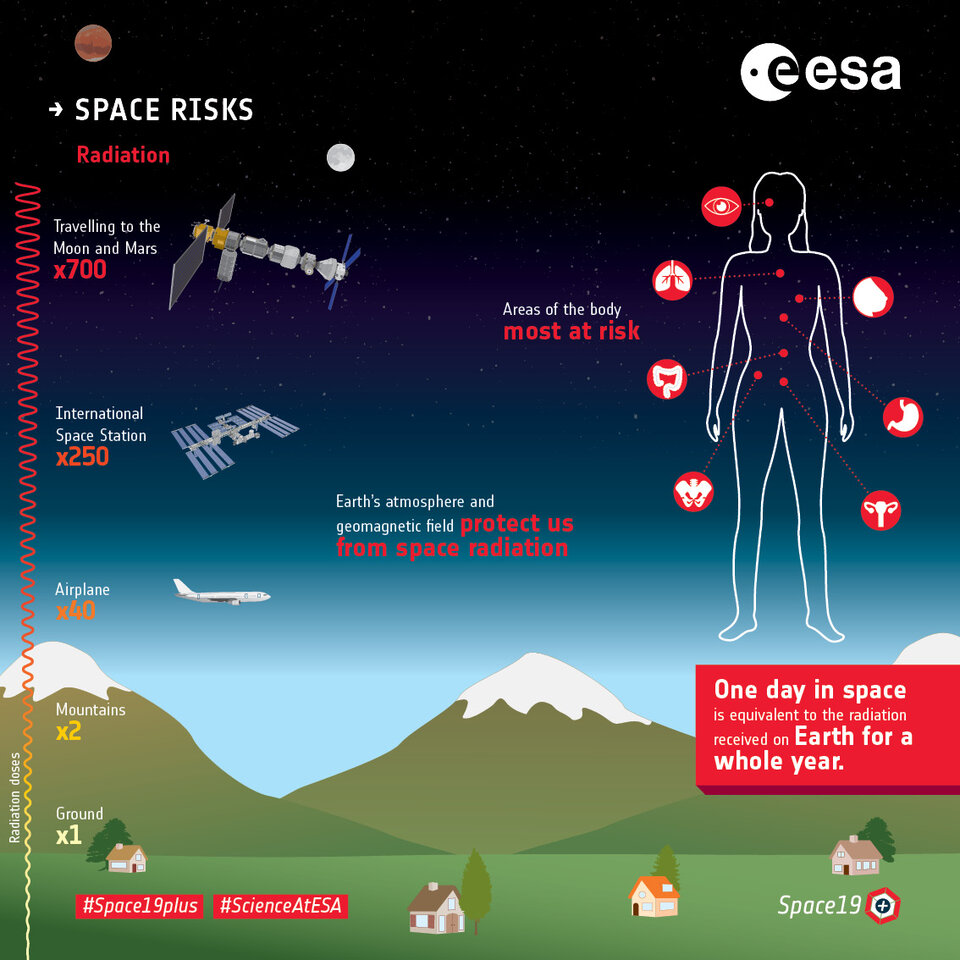
“One day in space is equivalent to the radiation received on Earth for a whole year,” explains physicist Marco Durante, who studies cosmic radiation on Earth.
Marco points out that most of the changes in the astronauts’ gene expression are believed to be a result of radiation exposure, according to the recent NASA’s Twins study . This research showed DNA damage in astronaut Scott Kelly compared to his identical twin and fellow astronaut Mark Kelly, who remained on Earth.
A second source of space radiation comes from unpredictable solar particle events that deliver high doses of radiation in a short period of time, leading to ‘radiation sickness’ unless protective measures are taken.
Europe’s radiation fight club
“The real problem is the large uncertainty surrounding the risks. We don’t understand space radiation very well and the long-lasting effects are unknown,” explains Marco who is also part of an ESA team formed to investigate radiation.
Since 2015, this forum of experts provides advice from areas such as space science, biology, epidemiology, medicine and physics to improve protection from space radiation.
“Space radiation research is an area that crosses the entire life and physical sciences area with important applications on Earth. Research in this area will remain of high priority for ESA,” says Jennifer Ngo-Anh, ESA’s team leader human research, biology and physical sciences.

While astronauts are not considered radiation workers in all countries, they are exposed to 200 times more radiation on the International Space Station than an airline pilot or a radiology nurse.
Radiation is in the Space Station’s spotlight every day. A console at NASA’s mission control in Houston, Texas, is constantly showing space weather information.
If a burst of space radiation is detected, teams on Earth can abort a spacewalk, instruct astronauts to move to more shielded areas and even change the altitude of the Station to minimise impact.
One of the main recommendations of the topical team is to develop a risk model with the radiation dose limits for crews travelling beyond the International Space Station.
ESA’s flight surgeon and radiologist Ulrich Straube believes that the model should “provide information on the risks that could cause cancer and non-cancer health issues for astronauts going to the Moon and Mars in agreement with all space agencies.”
Recent data from ExoMars Trace Gas Orbiter showed that on a six-month journey to the Red Planet an astronaut could be exposed to at least 60% of the total radiation dose limit recommended for their entire career.
“As it stands today, we can’t go to Mars due to radiation. It would be impossible to meet acceptable dose limits,” reminds Marco.
Measure to protect

ESA has teamed up with five particle accelerators in Europe that can recreate cosmic radiation by ‘shooting’ atomic particles to speeds approaching the speed of light. Researchers have been bombarding biological cells and materials with radiation to understand how to best protect astronauts.
“The research is paying off. Lithium is standing out as a promising material for shielding in planetary missions,” says Marco.
ESA has been measuring the radiation dose on the International Space Station for seven years with passive radiation detectors in the DOSIS 3D experiment . ESA astronauts Andreas Mogensen and Thomas Pesquet wore a new mobile dosimeter during their missions that gave them a real-time snapshot of their exposure.
The same European team behind this research will provide radiation detectors to monitor the skin and organ doses of the two phantoms traveling to the Moon onboard NASA’s Orion spacecraft.
ESA has demonstrated expertise in studying Mars from orbit, now we are looking to secure a safe landing, to rove across the surface and to drill underground to search for evidence of life. Our orbiters are already in place to provide data relay services for surface missions. The next logical step is to bring samples back to Earth, to provide access to Mars for scientists globally, and to better prepare for future human exploration of the Red Planet. This week we’re highlighting ESA’s contribution to Mars exploration as we ramp up to the launch of our second ExoMars mission, and look beyond to completing a Mars Sample Return mission. Join the conversation online with the hashtag #ExploreFarther
Thank you for liking
You have already liked this page, you can only like it once!
Related Articles

New radiation research programme for human spaceflight
Cosmic opportunity for radiation research at esa.

Active tracking of astronaut rad-exposures targeted
Related links.

Research Announcements
Experiment archive.

CIMAP – Centre de Recherche sur les Ions, les Matériaux et …
CIMAP – Centre de Recherche sur les Ions, les Matériaux et la Photonique
AGOR – Accélérateur Groningen-ORsay
GANIL – Grand Accélérateur National d’Ions Lourds
HIT – Heidelberg Ion-Beam Therapy Center
PTC – Protonen Therapie Dresden

TIFPA - Trento Institute for Fundamental Physics and Applic…
http://www.tifpa.infn.it/
How long does it take to get to Mars?
We explore how long it takes to get to Mars and the factors that affect a journey to the Red Planet.
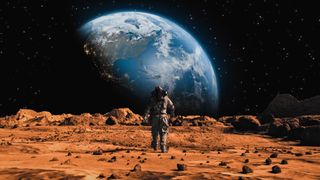
- Distance to Mars
- Traveling at the speed of light
Fastest spacecraft so far
Mars travel time q&a with an expert.
- Travel time calculation problems
- Past mission's travel times
Additional resources
Ever wondered how long does it take to get to Mars?
The answer depends on several factors, ranging from the position of Earth and Mars to the technology that would propel you there. According to NASA , a one-way trip to the Red Planet would take about nine months . If you wanted to make it a round-trip , all in all, it would take about 21 months as you will need to wait about three months on Mars to make sure Earth and Mars are in a suitable location to make the trip back home.
We take a look at how long a trip to the Red Planet would take using available technology and explore some of the factors that would affect your travel time.
Related: Curiosity rover: 15 awe-inspiring photos of Mars (gallery)
How far away is Mars?
To determine how long it will take to reach Mars, we must first know the distance between the two planets.
Mars is the fourth planet from the sun, and the second closest to Earth (Venus is the closest). But the distance between Earth and Mars is constantly changing as they travel around the sun .
In theory, the closest that Earth and Mars would approach each other would be when Mars is at its closest point to the sun (perihelion) and Earth is at its farthest (aphelion). This would put the planets only 33.9 million miles (54.6 million kilometers) apart. However, this has never happened in recorded history. The closest recorded approach of the two planets occurred in 2003 when they were only 34.8 million miles (56 million km) apart.
The two planets are farthest apart when they are both at their farthest from the sun, on opposite sides of the star. At this point, they can be 250 million miles (401 million km) apart.
The average distance between Earth and Mars is 140 million miles (225 million km).
Related: What is the temperature on Mars?
How long would it take to travel to Mars at the speed of light?

Light travels at approximately 186,282 miles per second (299,792 km per second). Therefore, a light shining from the surface of Mars would take the following amount of time to reach Earth (or vice versa):
- Closest possible approach: 182 seconds, or 3.03 minutes
- Closest recorded approach: 187 seconds, or 3.11 minutes
- Farthest approach: 1,342 seconds, or 22.4 minutes
- On average: 751 seconds, or just over 12.5 minutes
The fastest spacecraft is NASA's Parker Solar Probe , as it keeps breaking its own speed records as it moves closer to the sun. On Nov 21, 2021, the Parker Solar Probe reached a top speed of 101 miles (163 kilometers) per second during its 10th close flyby of our star, which translates to a phenomenal 364,621 mph (586,000 kph). According to a NASA statement , when the Parker Solar Probe comes within 4 million miles (6.2 million kilometers) of the solar surface in December 2024, the spacecraft's speed will top 430,000 miles per hour (692,000 kph)!
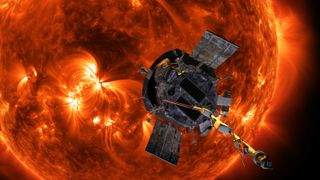
So if you were theoretically able to hitch a ride on the Parker Solar Probe and take it on a detour from its sun-focused mission to travel in a straight line from Earth to Mars, traveling at the speeds the probe reaches during its 10th flyby (101 miles per second), the time it would take you to get to Mars would be:
- Closest possible approach: 93 hours
- Closest recorded approach: 95 hours
- Farthest approach: 686 hours (28.5 days)
- On average: 384 hours (16 days)
We asked Michael Khan, ESA Senior Mission Analyst some frequently asked questions about travel times to Mars.
Michael Khan is a Senior Mission Analyst for the European Space Agency (ESA). His work involves studying the orbital mechanics for journeys to planetary bodies including Mars.
How long does it take to get to Mars & what affects the travel time?
The time it takes to get from one celestial body to another depends largely on the energy that one is willing to expend. Here "energy" refers to the effort put in by the launch vehicle and the sum of the maneuvers of the rocket motors aboard the spacecraft, and the amount of propellant that is used. In space travel, everything boils down to energy. Spaceflight is the clever management of energy.
Some common solutions for transfers to the moon are 1) the Hohmann-like transfer and 2) the Free Return Transfer. The Hohmann Transfer is often referred to as the one that requires the lowest energy, but that is true only if you want the transfer to last only a few days and, in addition, if some constraints on the launch apply. Things get very complicated from there on, so I won't go into details.
Concerning transfers to Mars, these are by necessity interplanetary transfers, i.e., orbits that have the sun as central body. Otherwise, much of what was said above applies: the issue remains the expense of energy. An additional complication lies in the fact that the Mars orbit is quite eccentric and also its orbit plane is inclined with respect to that of the Earth. And of course, Mars requires longer to orbit the sun than the Earth does. All of this is taken into account in a common type of diagram called the "pork chop plot", which essentially tells you the required dates of departure and arrival and the amount of energy required.
The "pork chop plot" shows the trajectory expert that opportunities for Mars transfers arise around every 25-26 months, and that these transfers are subdivided into different classes, one that is a bit faster, with typically around 5-8 months and the other that takes about 7-11 months. There are also transfers that take a lot longer, but I’m not talking about those here. Mostly, but not always, the second, slower one turns out to be more efficient energy-wise. A rule of thumb is that the transfer to Mars takes around as long as the human period of gestation, approximately 9 months. But that really is no more than an approximate value; you still have to do all the math to find out what applies to a specific date.
Why are journey times a lot slower for spacecraft intending to orbit or land on the target body e.g. Mars compared to those that are just going to fly by?
If you want your spacecraft to enter Mars orbit or to land on the surface, you add a lot of constraints to the design problem. For an orbiter, you have to consider the significant amount of propellant required for orbit insertion, while for a lander, you have to design and build a heat shield that can withstand the loads of atmospheric entry. Usually, this will mean that the arrival velocity of Mars cannot exceed a certain boundary. Adding this constraint to the trajectory optimisation problem will limit the range of solutions you obtain to transfers that are Hohmann-like. This usually leads to an increase in transfer duration.
The problems with calculating travel times to Mars
The problem with the previous calculations is that they measure the distance between the two planets as a straight line. Traveling through the farthest passing of Earth and Mars would involve a trip directly through the sun, while spacecraft must of necessity move in orbit around the solar system's star.
Although this isn't a problem for the closest approach, when the planets are on the same side of the sun, another problem exists. The numbers also assume that the two planets remain at a constant distance; that is, when a probe is launched from Earth while the two planets are at the closest approach, Mars would remain the same distance away over the length of time it took the probe to travel.
Related: A brief history of Mars missions
In reality, however, the planets are moving at different rates during their orbits around the sun. Engineers must calculate the ideal orbits for sending a spacecraft from Earth to Mars. Like throwing a dart at a moving target from a moving vehicle, they must calculate where the planet will be when the spacecraft arrives, not where it is when it leaves Earth.
It's also not possible to travel as fast as you can possibly go if your aim is to eventually orbit your target planet. Spacecraft need to arrive slow enough to be able to perform orbit insertion maneuvers and not just zip straight past their intended destination.
The travel time to Mars also depends on the technological developments of propulsion systems.
According to NASA Goddard Space Flight Center's website, the ideal lineup for a launch to Mars would get you to the planet in roughly nine months. The website quotes physics professor Craig C. Patten , of the University of California, San Diego:
"It takes the Earth one year to orbit the sun and it takes Mars about 1.9 years (say 2 years for easy calculation) to orbit the sun. The elliptical orbit which carries you from Earth to Mars is longer than Earth's orbit but shorter than Mars' orbit. Accordingly, we can estimate the time it would take to complete this orbit by averaging the lengths of Earth's orbit and Mars' orbit. Therefore, it would take about one and a half years to complete the elliptical orbit.
"In the nine months it takes to get to Mars, Mars moves a considerable distance around in its orbit, about three-eighths of the way around the sun. You have to plan to make sure that by the time you reach the distance of Mar's orbit, Mars is where you need it to be! Practically, this means that you can only begin your trip when Earth and Mars are properly lined up. This only happens every 26 months. That is, there is only one launch window every 26 months."
The trip could be shortened by burning more fuel — a process not ideal with today's technology, Patten said.
Evolving technology can help to shorten the flight. NASA's Space Launch System (SLS) will be the new workhorse for carrying upcoming missions, and potentially humans, to the red planet. SLS is currently being constructed and tested, with NASA now targeting a launch in March or April 2022 for its Artemis 1 flight, the first flight of its SLS rocket.
Robotic spacecraft could one day make the trip in only three days. Photon propulsion would rely on a powerful laser to accelerate spacecraft to velocities approaching the speed of light. Philip Lubin, a physics professor at the University of California, Santa Barbara, and his team are working on Directed Energy Propulsion for Interstellar Exploration (DEEP-IN). The method could propel a 220-lb. (100 kilograms) robotic spacecraft to Mars in only three days, he said.
"There are recent advances which take this from science fiction to science reality," Lubin said at the 2015 NASA Innovative Advanced Concepts (NIAC) fall symposium . "There's no known reason why we cannot do this."
How long did past missions take to reach Mars?
Here is an infographic detailing how long it took several historical missions to reach the Red Planet (either orbiting or landing on the surface). Their launch dates are included for perspective.
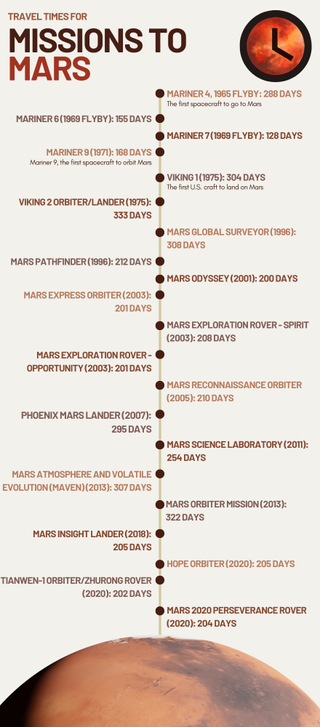
Explore NASA's lunar exploration plans with their Moon to Mars overview . You can read about how to get people from Earth to Mars and safely back again with this informative article on The Conversation . Curious about the human health risks of a mission to the Red Planet? You may find this research paper of particular interest.
Bibliography
- Lubin, Philip. " A roadmap to interstellar flight. " arXiv preprint arXiv:1604.01356 (2016).
- Donahue, Ben B. " Future Missions for the NASA Space Launch System. " AIAA Propulsion and Energy 2021 Forum . 2021.
- Srinivas, Susheela. " Hop, Skip and Jump—The Moon to Mars Mission. " (2019).
Join our Space Forums to keep talking space on the latest missions, night sky and more! And if you have a news tip, correction or comment, let us know at: [email protected].
Get the Space.com Newsletter
Breaking space news, the latest updates on rocket launches, skywatching events and more!

Nola Taylor Tillman is a contributing writer for Space.com. She loves all things space and astronomy-related, and enjoys the opportunity to learn more. She has a Bachelor’s degree in English and Astrophysics from Agnes Scott college and served as an intern at Sky & Telescope magazine. In her free time, she homeschools her four children. Follow her on Twitter at @NolaTRedd
Virgin Galactic to launch 7th commercial spaceflight on June 8
China launches Chang'e 6 sample-return mission to moon's far side (video)
Where will the annular solar eclipse on Oct. 2, 2024 be visible?
Most Popular
- 2 Boeing Starliner rolls out to launch pad for 1st astronaut flight on May 6 (photos)
- 3 The history of the Jedi Order in 'Star Wars'
- 4 Star Wars Day 2024: 'Star Wars: Tales of the Empire' premieres today on Disney+
- 5 Free Comic Book Day 2024: Get Marvel Comics 'Star Wars #1' for free
- Skip to main content
- Keyboard shortcuts for audio player
NASA's administrator on ambitions to return to the moon
NPR's Scott Detrow speaks with NASA administrator Bill Nelson about the space agency's plans to return to the moon and travel later to Mars.

SpaceX reveals futuristic space suit, humans would wear this on Mars

ALBAWABA – Elon Musk’s SpaceX has revealed on X (formerly Twitter) a new Extravehicular Activity (EVA) suit, to be worn by the astronaut team of the Polaris Dawn commercial space mission, which will be carried out on a SpaceX Crew Dragon spacecraft this summer.
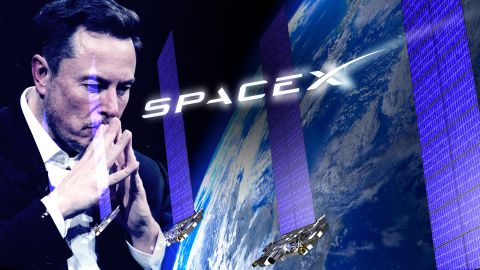
The new EVA suit, according to the spacecraft manufacturer, has been created with increased flexibility, safety, and performance in mind, and is intended to facilitate the first commercial astronaut spacewalk and serve as a critical milestone in SpaceX's quest to make humans multiplanetary.
The SpaceX Extravehicular Activity (EVA) suit → https://t.co/z2Z9iVpt6x #Maythe4thBeWithYou pic.twitter.com/peETlLCcDP --> — SpaceX (@SpaceX) May 4, 2024
The suit is an improvement on the SpaceX’s earlier Intravehicular Activity (IVA) suit. designed to give astronauts more freedom of movement, and features a cutting-edge helmet with a Heads-Up Display (HUD), a camera, new thermal management textiles, and materials derived from Falcon's interstage and Dragon's trunk.
SpaceX says that it will take an extensive number of spacesuits to establish a settlement on Mars and a base on the Moon, claiming that the creation of this suit and the upcoming spacewalk mission will represent significant advances toward a design that can be used on many more long-duration trips in the future as life spreads to other planets.
“The goal of this suit is to be our first design of the EVA suit, and then, just like all other SpaceX products, we’re going to continue through block upgrades as we go forward and learn,” said Stu Keech, Vice President of Dragon at SpaceX.
© 2000 - 2024 Al Bawaba (www.albawaba.com)
You may also like

Gallant opposes Netanyahu on recent ceasefire talks

Israeli analysts: "We've been dealt a painful blow by Turkey"

California University police disperse Pro-Palestinian students, dismantle Gaza camp

Mohamed Abdo begins chemotherapy in Paris amid Cancer diagnosis

Suggested Searches
- Climate Change
- Expedition 64
- Mars perseverance
- SpaceX Crew-2
- International Space Station
- View All Topics A-Z
Humans in Space
Earth & climate, the solar system, the universe, aeronautics, learning resources, news & events.

NASA’s Commercial Partners Deliver Cargo, Crew for Station Science

Hi-C Rocket Experiment Achieves Never-Before-Seen Look at Solar Flares

NASA Is Helping Protect Tigers, Jaguars, and Elephants. Here’s How.
- Search All NASA Missions
- A to Z List of Missions
- Upcoming Launches and Landings
- Spaceships and Rockets
- Communicating with Missions
- James Webb Space Telescope
- Hubble Space Telescope
- Why Go to Space
- Astronauts Home
- Commercial Space
- Destinations
- Living in Space
- Explore Earth Science
- Earth, Our Planet
- Earth Science in Action
- Earth Multimedia
- Earth Science Researchers
- Pluto & Dwarf Planets
- Asteroids, Comets & Meteors
- The Kuiper Belt
- The Oort Cloud
- Skywatching
- The Search for Life in the Universe
- Black Holes
- The Big Bang
- Dark Energy & Dark Matter
- Earth Science
- Planetary Science
- Astrophysics & Space Science
- The Sun & Heliophysics
- Biological & Physical Sciences
- Lunar Science
- Citizen Science
- Astromaterials
- Aeronautics Research
- Human Space Travel Research
- Science in the Air
- NASA Aircraft
- Flight Innovation
- Supersonic Flight
- Air Traffic Solutions
- Green Aviation Tech
- Drones & You
- Technology Transfer & Spinoffs
- Space Travel Technology
- Technology Living in Space
- Manufacturing and Materials
- Science Instruments
- For Kids and Students
- For Educators
- For Colleges and Universities
- For Professionals
- Science for Everyone
- Requests for Exhibits, Artifacts, or Speakers
- STEM Engagement at NASA
- NASA's Impacts
- Centers and Facilities
- Directorates
- Organizations
- People of NASA
- Internships
- Our History
- Doing Business with NASA
- Get Involved
- Aeronáutica
- Ciencias Terrestres
- Sistema Solar
- All NASA News
- Video Series on NASA+
- Newsletters
- Social Media
- Media Resources
- Upcoming Launches & Landings
- Virtual Events
- Sounds and Ringtones
- Interactives
- STEM Multimedia

Hubble Hunts Visible Light Sources of X-Rays

NASA Selects Students for Europa Clipper Intern Program

NASA Mission Strengthens 40-Year Friendship

NASA Selects Commercial Service Studies to Enable Mars Robotic Science

Two Small NASA Satellites Will Measure Soil Moisture, Volcanic Gases

NASA-Led Study Provides New Global Accounting of Earth’s Rivers

Orbits and Kepler’s Laws

X-ray Satellite XMM-Newton Sees ‘Space Clover’ in a New Light

NASA/JAXA’s XRISM Mission Captures Unmatched Data With Just 36 Pixels

Researchers Develop ‘Founding Document’ on Synthetic Cell Development

ARMD Solicitations

NASA Uses Small Engine to Enhance Sustainable Jet Research

NASA Photographer Honored for Thrilling Inverted In-Flight Image

Big Science Drives Wallops’ Upgrades for NASA Suborbital Missions

Tech Today: Stay Safe with Battery Testing for Space

NASA Grant Brings Students at Underserved Institutions to the Stars

Washington State High Schooler Wins 2024 NASA Student Art Contest

Asian-American and Native Hawaiian Pacific Islander Heritage Month

Diez maneras en que los estudiantes pueden prepararse para ser astronautas

Astronauta de la NASA Marcos Berríos

Resultados científicos revolucionarios en la estación espacial de 2023
- Jet Propulsion Laboratory
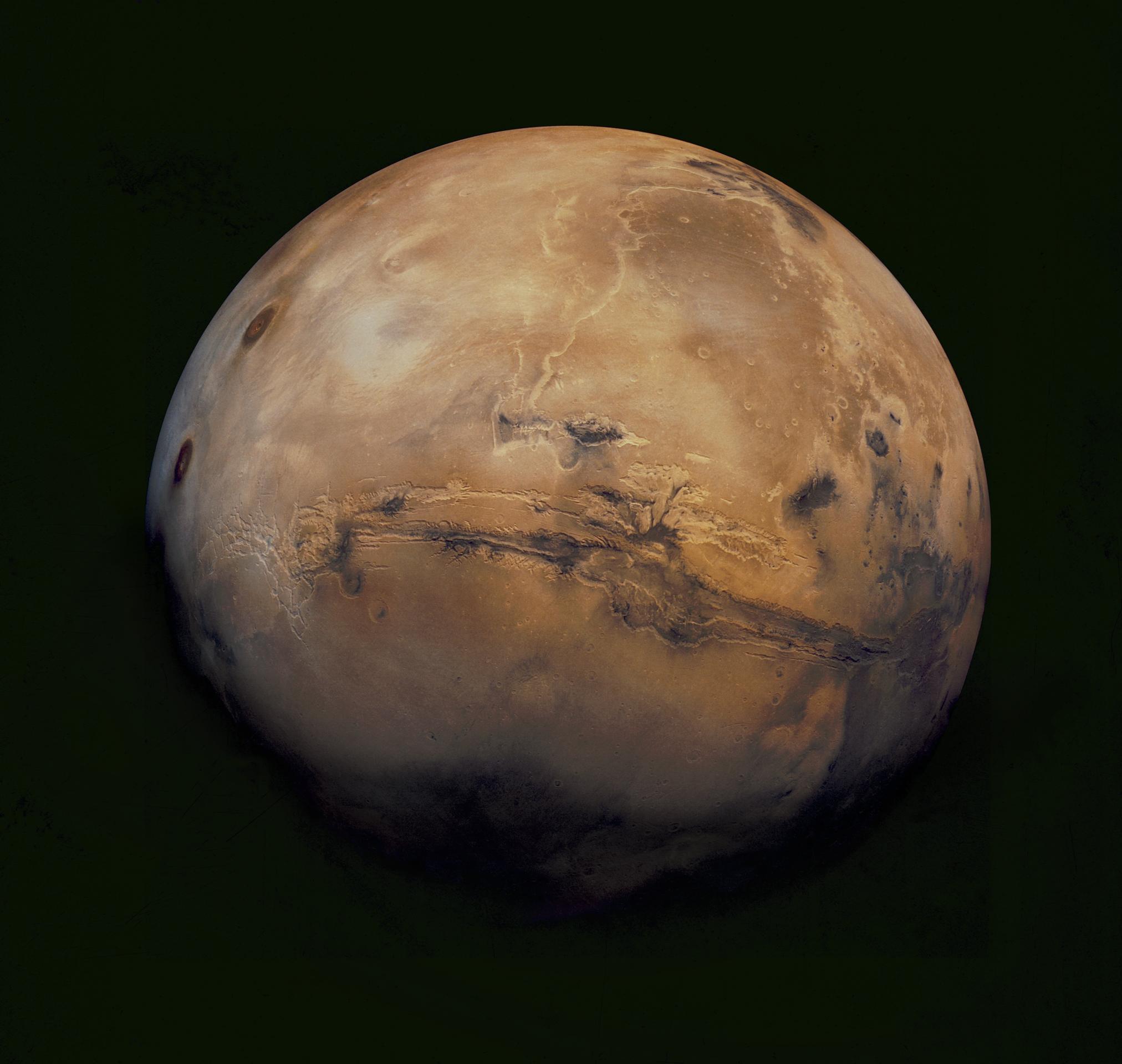
Nine companies have been selected to conduct early-stage studies of concepts for commercial services to support lower-cost, higher-frequency missions to the Red Planet.
NASA has identified nine U.S. companies to perform a total of 12 concept studies of how commercial services can be applied to enable science missions to Mars. Each awardee will receive between $200,000 and $300,000 to produce a detailed report on potential services — including payload delivery, communications relay, surface imaging, and payload hosting — that could support future missions to the Red Planet.
The companies were selected from among those that responded to a Jan. 29 request for proposals from U.S. industry.
NASA’s Mars Exploration Program initiated the request for proposals to help establish a new paradigm for missions to Mars with the potential to advance high-priority science objectives. Many of the selected proposals center on adapting existing projects currently focused on the Moon and Earth to Mars-based applications.
They include “space tugs” to carry other spacecraft to Mars, spacecraft to host science instruments and cameras, and telecommunications relays. The concepts being sought are intended to support a broad strategy of partnerships between government, industry, and international partners to enable frequent, lower-cost missions to Mars over the next 20 years.
“We’re in an exciting new era of space exploration, with rapid growth of commercial interest and capabilities,” said Eric Ianson, director of NASA’s Mars Exploration Program. “Now is the right time for NASA to begin looking at how public-private partnerships could support science at Mars in the coming decades.”
The selected Mars Exploration Commercial Services studies are divided into four categories:
Small payload delivery and hosting services
- Lockheed Martin Corporation, Littleton, Colorado — adapt a lunar-exploration spacecraft
- Impulse Space, Inc., Redondo Beach, California — adapt an Earth-vicinity orbital transfer vehicle (space tug)
- Firefly Aerospace, Cedar Park, Texas — adapt a lunar-exploration spacecraft
Large payload delivery and hosting services
- United Launch Services (ULA), LLC, Centennial, Colorado — modify an Earth-vicinity cryogenic upper stage
- Blue Origin, LLC, Kent, Washington — adapt an Earth- and lunar-vicinity spacecraft
- Astrobotic Technology, Inc., Pittsburgh — modify a lunar-exploration spacecraft
Mars surface-imaging services
- Albedo Space Corporation, Broomfield, Colorado — adapt a low Earth orbit imaging satellite
- Redwire Space, Inc., Littleton, Colorado — modify a low Earth orbit commercial imaging spacecraft
- Astrobotic Technology, Inc. — modify a lunar exploration spacecraft to include imaging
Next-generation relay services
- Space Exploration Technologies Corporation (SpaceX), Hawthorne, California — adapt Earth-orbit communication satellites for Mars
- Lockheed Martin Corporation — provide communication relay services via a modified Mars orbiter
- Blue Origin, LLC — provide communication relay services via an adapted Earth- and lunar-vicinity spacecraft
The 12-week studies are planned to conclude in August, and a study summary will be released later in the year. These studies could potentially lead to future requests for proposals but do not constitute a NASA commitment.
NASA is concurrently requesting separate industry proposals for its Mars Sample Return campaign, which seeks to bring samples being collected by the agency’s Perseverance rover to Earth, where they can be studied by laboratory equipment too large and complex to bring to Mars. The MSR industry studies are completely independent of the MEP commercial studies.
NASA’s Jet Propulsion Laboratory in Southern California manages the Mars Exploration Program on behalf of NASA’s Science Mission Directorate in Washington. The goal of the program is to provide a continuous flow of scientific information and discovery through a carefully selected series of robotic orbiters, landers, and mobile laboratories interconnected by a high-bandwidth Mars-Earth communications network. Scientific data and associated information for all Mars Exploration Program missions are archived in the NASA Planetary Data System.
Caltech in Pasadena, California, manages JPL for NASA.
News Media Contacts
Andrew Good Jet Propulsion Laboratory, Pasadena, Calif. 818-393-2433 [email protected]
Karen Fox / Charles Blue NASA Headquarters, Washington 301-286-6284 / 202-802-5345 [email protected] / [email protected]
Related Terms
- Science-enabling Technology
- Space Communications Technology
- Technology Research
- The Future of Commercial Space
Explore More

NASA Scientists Gear Up for Solar Storms at Mars

Major Martian Milestones
There’s good news from NASA’s Cloudspotting on Mars project! That’s the project that invites you to…
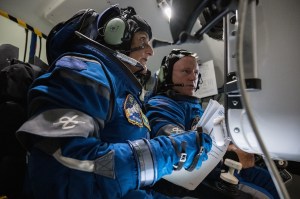

All Mars Resources

Sol 4171: Right Navigation Camera, Cylindrical Projection
Curiosity took the images on May 01, 2024, Sol 4171 of the Mars Science Laboratory mission at drive 6, site…

Sol 4169: Right Navigation Camera, Cylindrical Projection
Curiosity took the images on April 29, 2024, Sol 4169 of the Mars Science Laboratory mission at drive 0, site…

Sol 4166: Right Navigation Camera, Cylindrical Projection
Curiosity took the images on April 26, 2024, Sol 4166 of the Mars Science Laboratory mission at drive 3182, site…

Sol 4155: Left Navigation Camera, Vertical Projection
This projection provides an overhead view, but introduces distortion for items not on the surface, such as large rocks and…
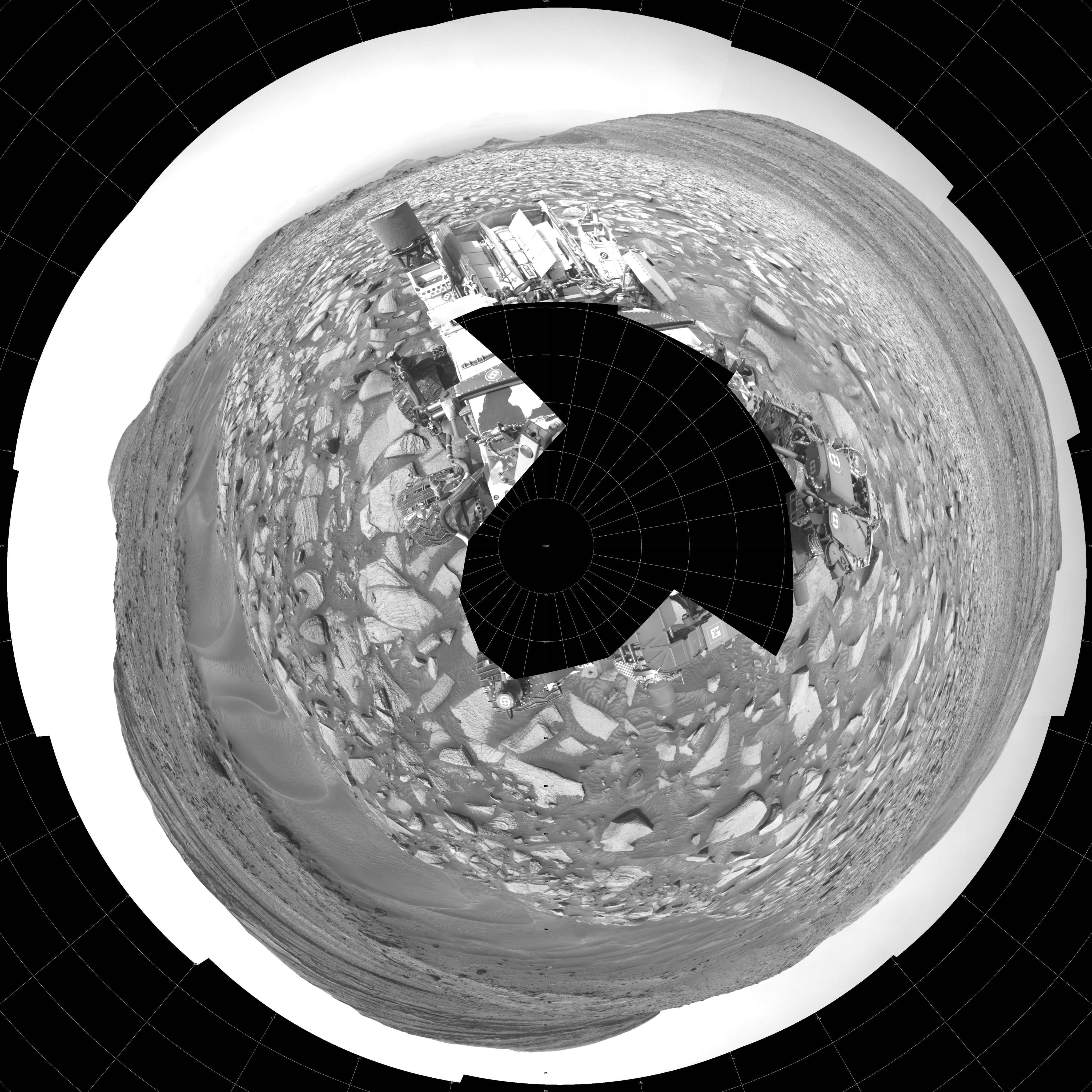
Sol 4155: Left Navigation Camera, Polar Projection
Curiosity took the images on April 14, 2024, Sol 4155 of the Mars Science Laboratory mission at drive 2386, site…

Sol 4155: Left Navigation Camera, Cylindrical Projection

Sol 4164: Right Navigation Camera, Cylindrical Projection
Curiosity took the images on April 24, 2024, Sol 4164 of the Mars Science Laboratory mission at drive 2950, site…

Sol 4162: Right Navigation Camera, Cylindrical Projection
Curiosity took the images on April 22, 2024, Sol 4162 of the Mars Science Laboratory mission at drive 2836, site…
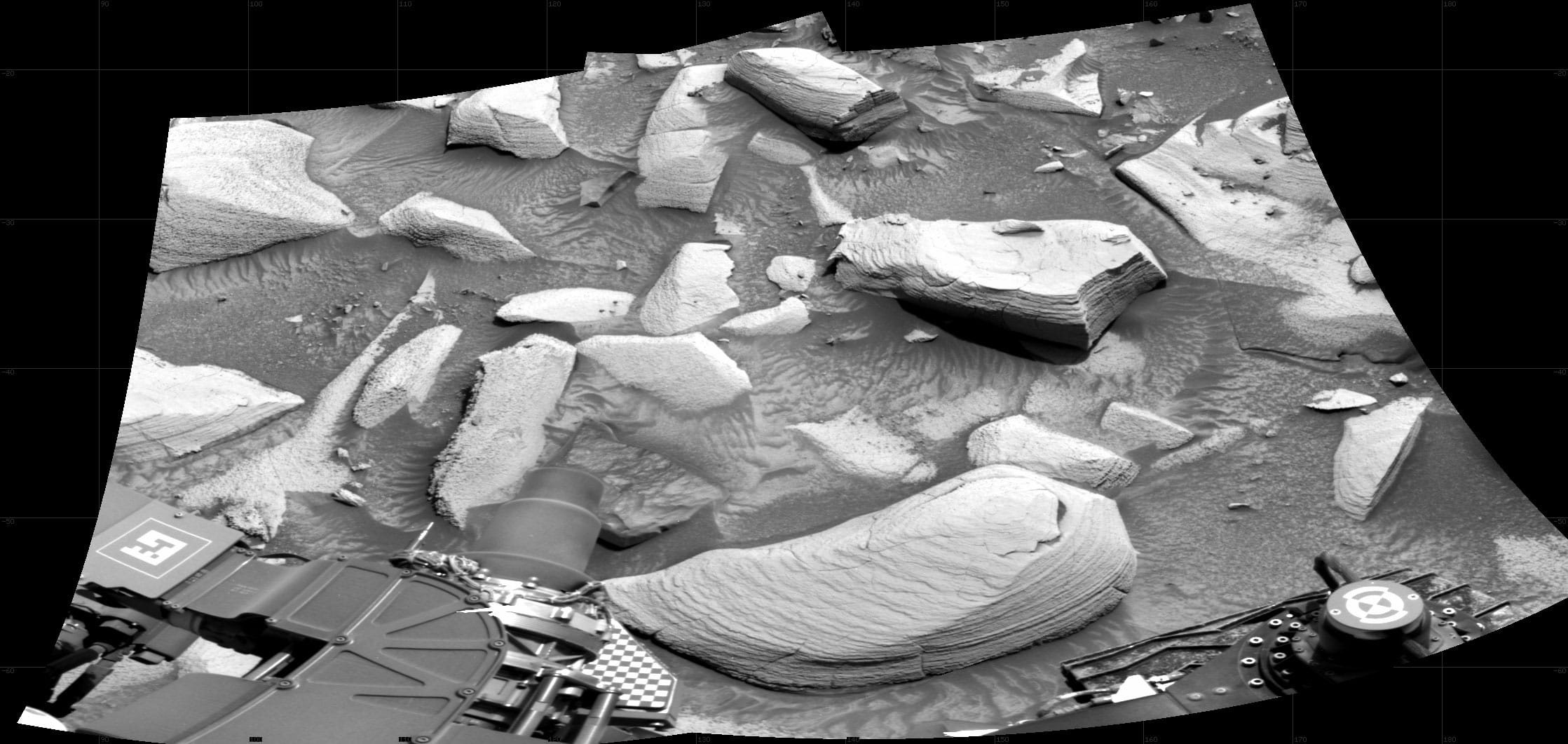
Sol 4159: Right Navigation Camera, Cylindrical Projection
Curiosity took the images on April 19, 2024, Sol 4159 of the Mars Science Laboratory mission at drive 2692, site…
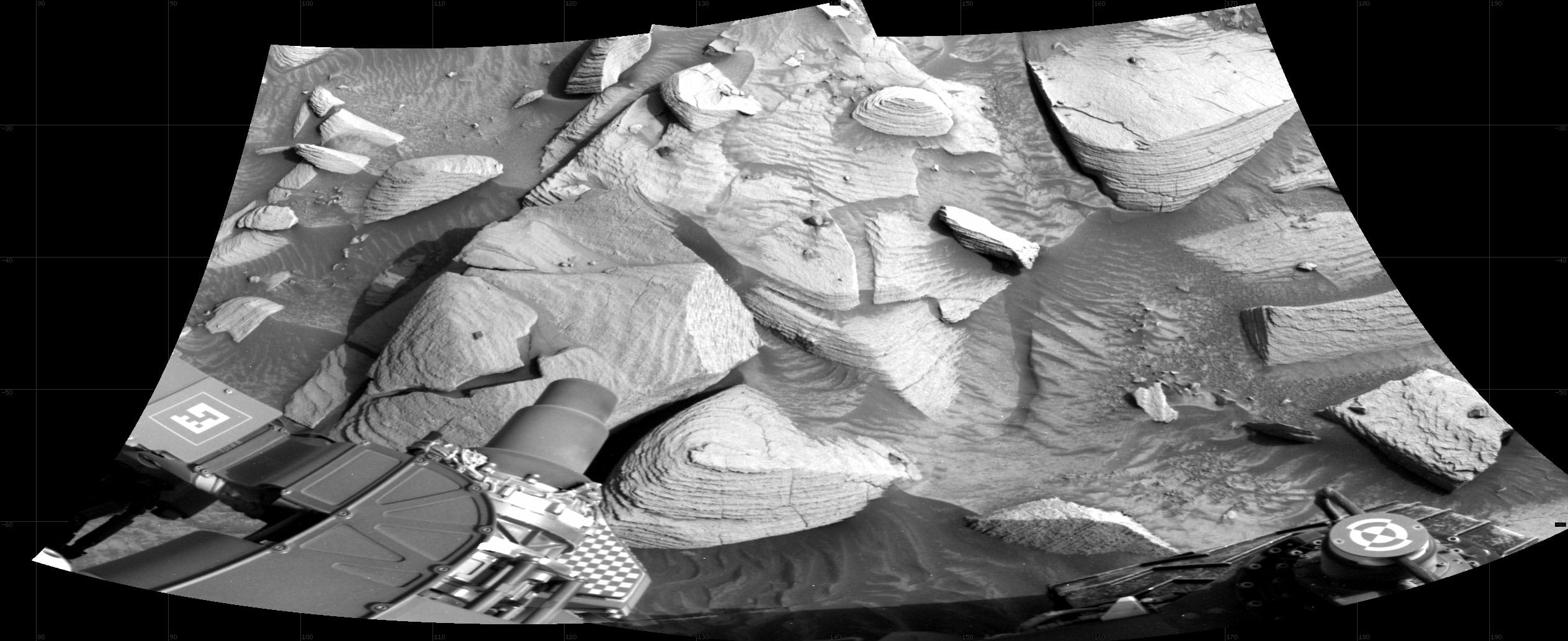
Sol 4158: Right Navigation Camera, Cylindrical Projection
Curiosity took the images on April 17, 2024, Sol 4158 of the Mars Science Laboratory mission at drive 2596, site…

IMAGES
VIDEO
COMMENTS
SpaceX's Starship spacecraft and Super Heavy rocket - collectively referred to as Starship - represent a fully reusable transportation system designed to carry both crew and cargo to Earth orbit, the Moon, Mars and beyond. Starship is the world's most powerful launch vehicle ever developed, capable of carrying up to 150 metric tonnes ...
Temperatures on Mars can range from -284 degrees F to 86 degrees F. The atmosphere on Mars is 96% carbon dioxide. One day on Mars lasts about 37 minutes longer than an Earth day. A year on Mars is almost twice as long as a year on Earth. Gravity on Mars is about one-third of the gravity on Earth.
NASA is reimagining the future of Mars exploration, driving new scientific discoveries, and preparing for humans on Mars. NASA's Mars Exploration Program will focus the next two decades on its science-driven systemic approach on these strategic goals: exploring for potential life, understanding the geology and climate of Mars, and preparation for human exploration.
Like the Moon, Mars is a rich destination for scientific discovery and a driver of technologies that will enable humans to travel and explore far from Earth. Mars remains our horizon goal for human exploration because it is one of the only other places we know in the solar system where life may have existed.
Oct 08, 2015. RELEASE 15-206. NASA is leading our nation and the world on a journey to Mars, and Thursday the agency released a detailed outline of that plan in its report, "NASA's Journey to Mars: Pioneering Next Steps in Space Exploration.". "NASA is closer to sending American astronauts to Mars than at any point in our history ...
Orion is the first spacecraft built for astronauts destined for deep space since the storied Apollo missions of the 1960s and 70s. It is designed to go farther than humans have ever traveled, well beyond the moon, pushing the boundaries of spaceflight to new heights. Orion will open the space between Earth and Mars for exploration by astronauts.
The Mars 2020 Perseverance Rover searches for signs of ancient microbial life, to advance NASA's quest to explore the past habitability of Mars. The rover is collecting core samples of Martian rock and soil (broken rock and soil), for potential pickup by a future mission that would bring them to Earth for detailed study. Type.
Pre-launch Activities Preparation for the mission, including pre-project planning, science definition and instrument selection, landing site selection, assembly and testing, and delivery to the launch site. Launch Liftoff from Earth. Cruise: The Trip to Mars The interplanetary cruise phase is the period of travel from Earth to Mars and lasts about 200 days.
The future of spaceflight—from orbital vacations to humans on Mars. NASA aims to travel to the moon again—and beyond. Here's a look at the 21st-century race to send humans into space.
Once every 26 months, Earth and Mars are aligned in a way that minimizes travel times and expense, enabling spacecraft to make the interplanetary journey in roughly half a year. Earth's space ...
The agency released its top objectives for a 30-day, two-person Mars surface mission on Tuesday (May 17) and asked the public to provide feedback on how the planning is going. Submissions were ...
(Mars aligns with Earth favorably for spacecraft missions every 26 months; the upcoming window, in late July and early August 2020, may see three different robotic missions launch to the Red Planet.)
DARPA. NASA has hired Lockheed Martin to design, build, and test a nuclear-powered rocket for space travel. The technology could speed up a manned trip to Mars from the current seven-month minimum ...
Four volunteers will learn what it's like to work and live on the Red Planet for 45 days. NASA has selected four volunteers to go on a mission to Mars — without actually leaving Earth. The ...
The agency is investing in projects to develop new propulsion technologies that might enable more expeditious space travel. A crooked path to Mars. In a science-fictional world, a spacecraft would ...
Astronauts bound for Mars will travel about 140 million miles into deep space. Advancements in propulsion capabilities are the key to reaching our destination as quickly and safely as possible. It is too soon to say which propulsion system will take astronauts to Mars, but we know it needs to be nuclear-enabled to reduce travel time.
Human Space Travel Research; Explore; ... InSight was the first space robotic explorer to study in-depth the "inner space" of Mars: its crust, mantle, and core. (2018-2022) Read More. MAVEN. MAVEN is obtaining critical measurements of Mars' atmosphere to help understand dramatic climate change over the planet's history. (2013-present)
Sept. 1, 2022. Human beings will soon walk on the moon again, if NASA gets its way. NASA plans to launch an uncrewed spacecraft, part of the Artemis I mission, as soon as this weekend to orbit the ...
An astronaut on a mission to Mars could receive radiation doses up to 700 times higher than on our planet - a major showstopper for the safe exploration of our Solar System. ... energetic particles that travel at close to the speed of light and penetrate the human body. ... "Space radiation research is an area that crosses the entire life ...
Therefore, a light shining from the surface of Mars would take the following amount of time to reach Earth (or vice versa): Closest possible approach: 182 seconds, or 3.03 minutes. Closest ...
NASA Technology Grants to Advance Moon to Mars Space Exploration 2 min read NASA has awarded nearly $1.5 million to academic, non-profit, and business organizations to advance state-of-the-art technology that will play a key role in the agency's return to the Moon under Artemis, as well as future missions to Mars.
Notably, this propulsion system would produce up to 100,000 N of thrust with a specific impulse (Isp) of 5,000 seconds — meeting the two primary requirements for deep space missions.
Officials with the National Aeronautics and Space Administration will pay nine companies between $200,000 and $300,000 each to conduct a dozen tests to support future missions to Mars.
NPR's Scott Detrow speaks with NASA administrator Bill Nelson about the space agency's plans to return to the moon and travel later to Mars.
Travel to the Moon, Mars, and beyond will require new systems to provide medical care far from Earth. Learn more about the changes humans may undergo during spaceflight, as well as the steps NASA takes to keep astronauts healthy and safe. NASA astronaut and Flight Engineer Andrew Morgan flexes his muscles in an airlock of the space station.
Perseverance's Route to Mars. July 28, 2020. Credit. NASA/JPL-Caltech. Language. english. Illustration of the route Mars 2020 takes to the Red Planet, including several trajectory correction maneuvers (TCMs) to adjust its flight path. (Updated Aug 17, 2020)
SpaceX says that it will take an extensive number of spacesuits to establish a settlement on Mars and a base on the Moon, claiming that the creation of this suit and the upcoming spacewalk mission ...
They include "space tugs" to carry other spacecraft to Mars, spacecraft to host science instruments and cameras, and telecommunications relays. The concepts being sought are intended to support a broad strategy of partnerships between government, industry, and international partners to enable frequent, lower-cost missions to Mars over the ...
May 2, 2024. A mineral you may have never heard of is adding new fuel to the fire that ancient Mars may have looked like our planet Earth. Watch the video to learn about the new discovery.
Curiosity took the images on April 19, 2024, Sol 4159 of the Mars Science Laboratory mission at drive 2692, site… Sol 4158: Right Navigation Camera, Cylindrical Projection Curiosity took the images on April 17, 2024, Sol 4158 of the Mars Science Laboratory mission at drive 2596, site…